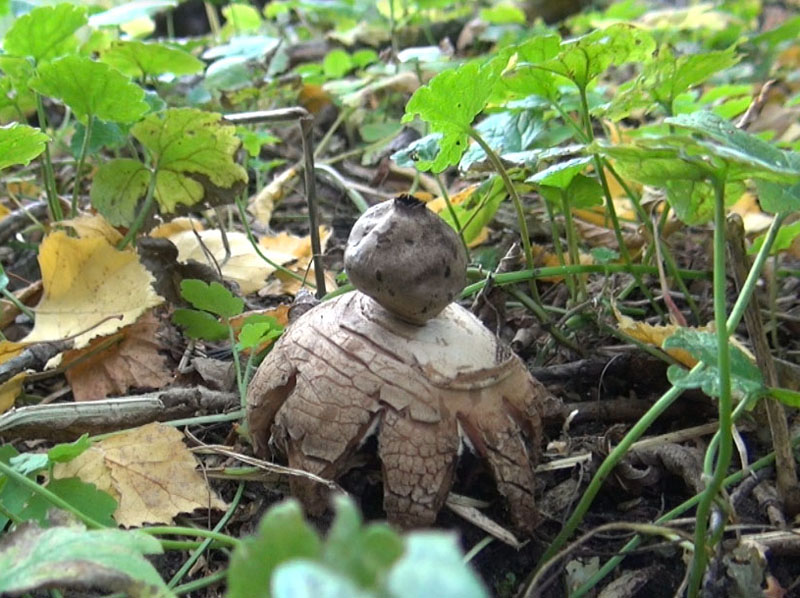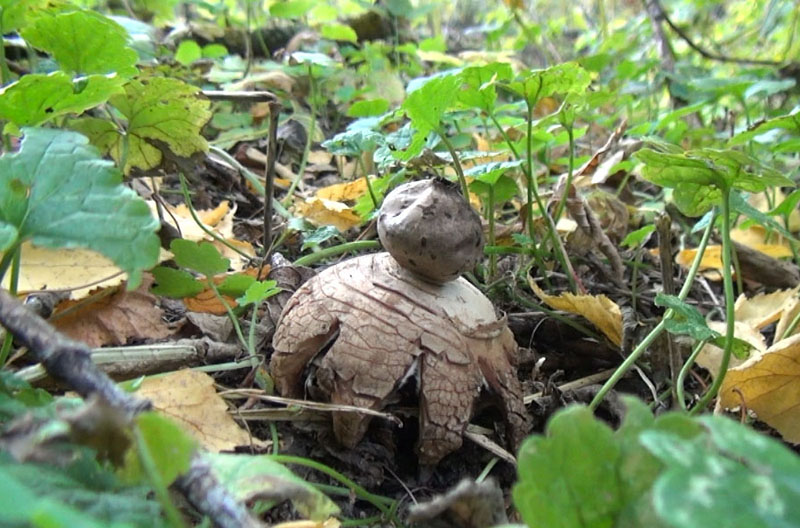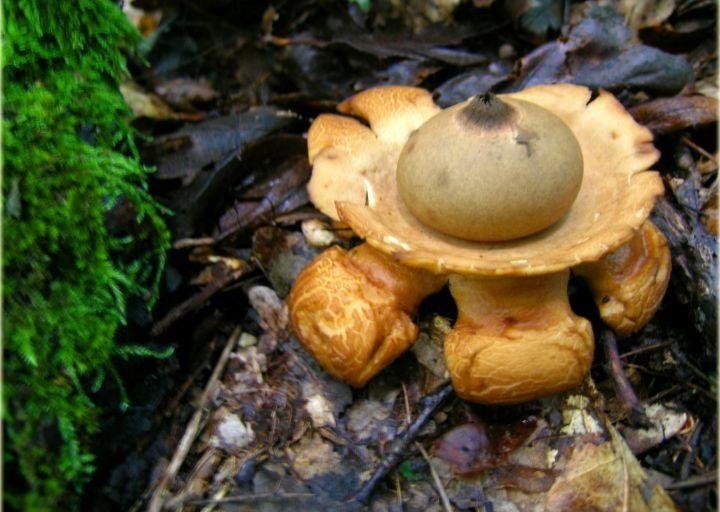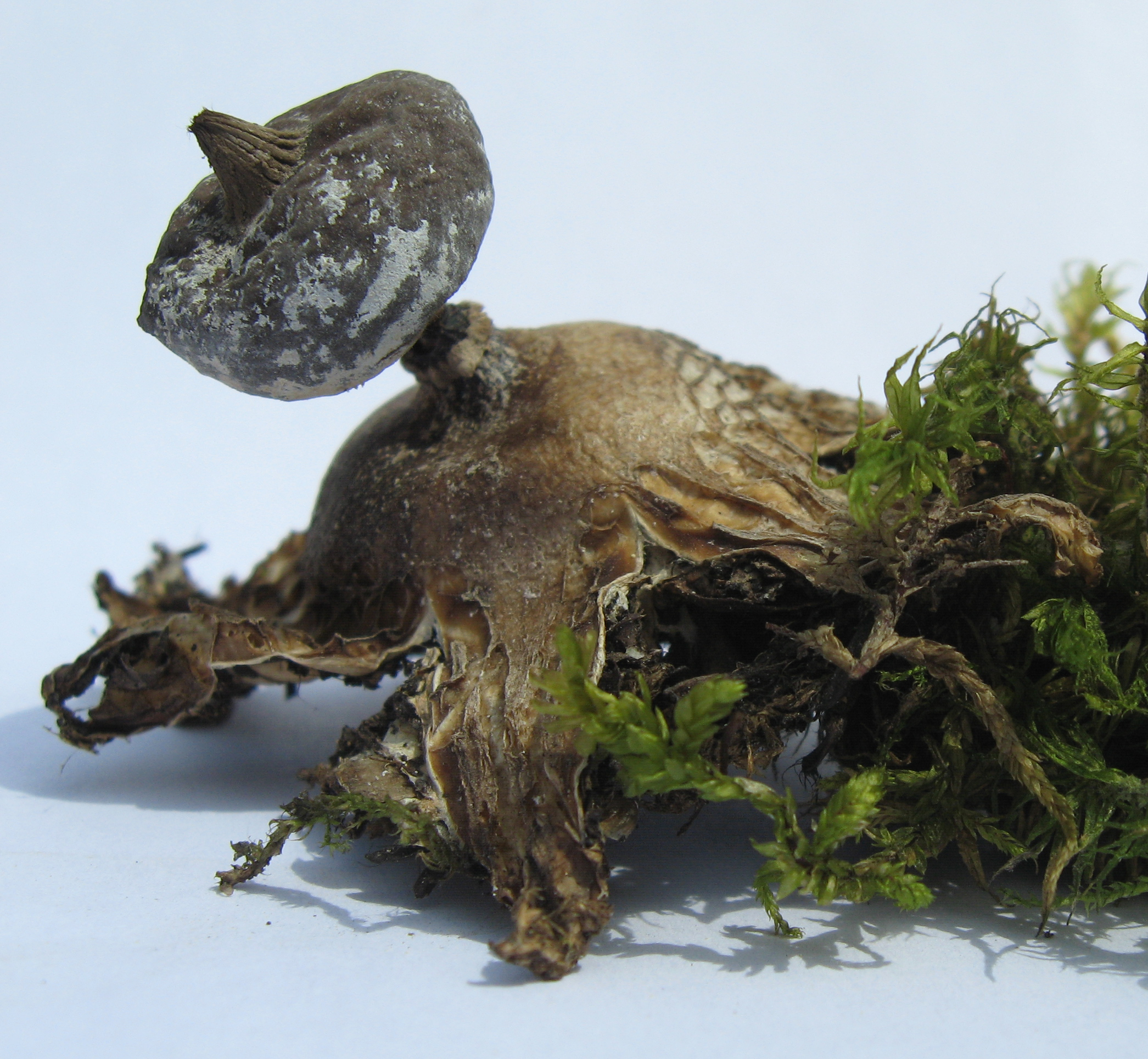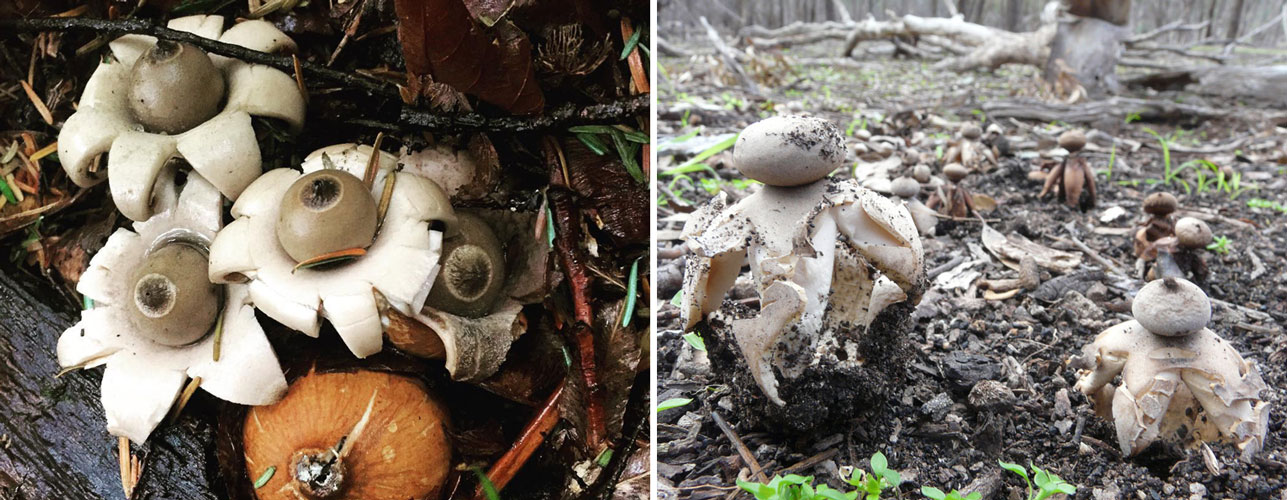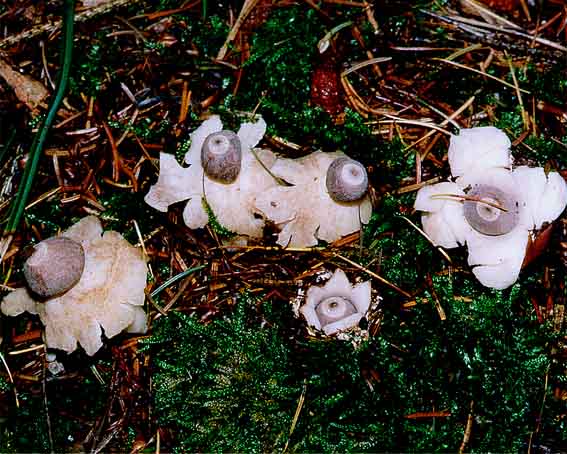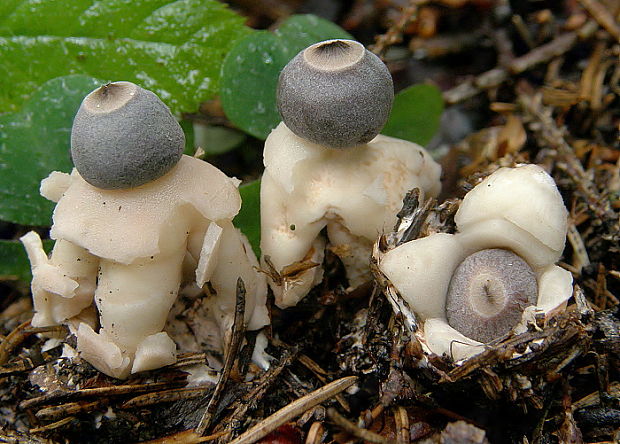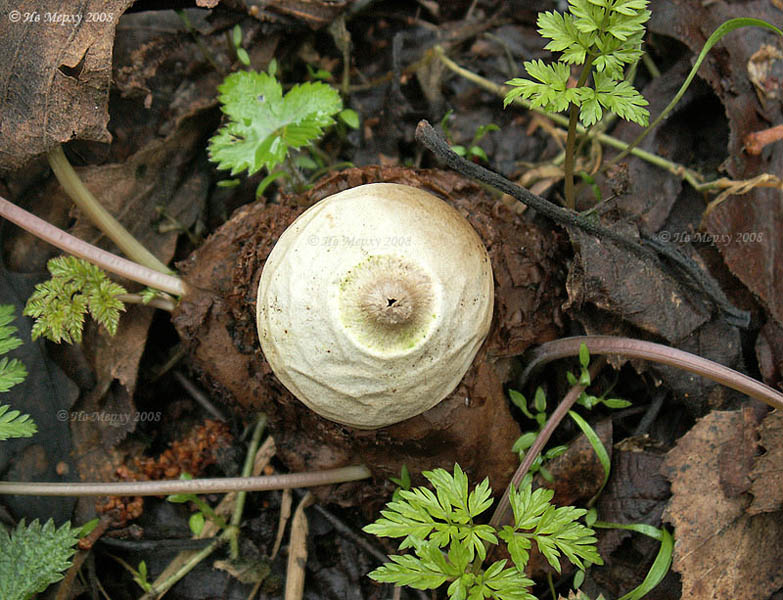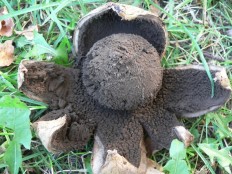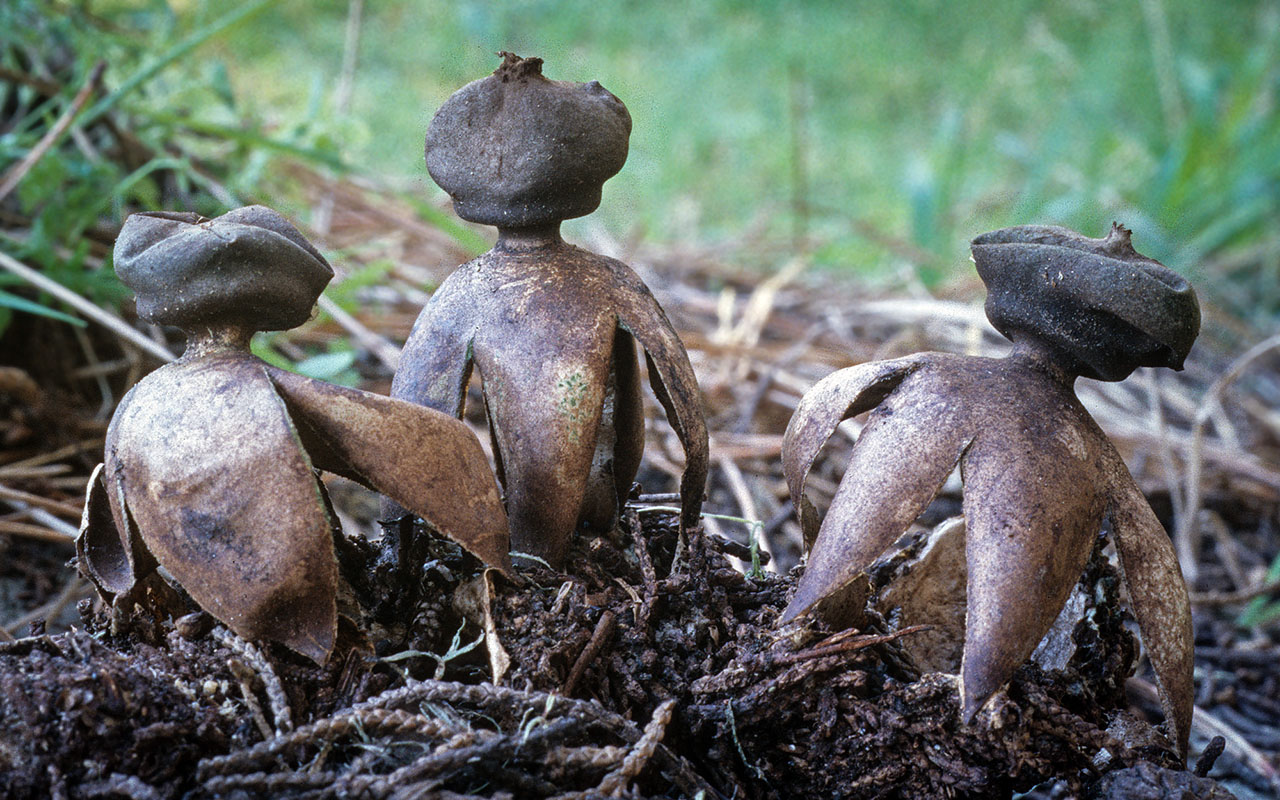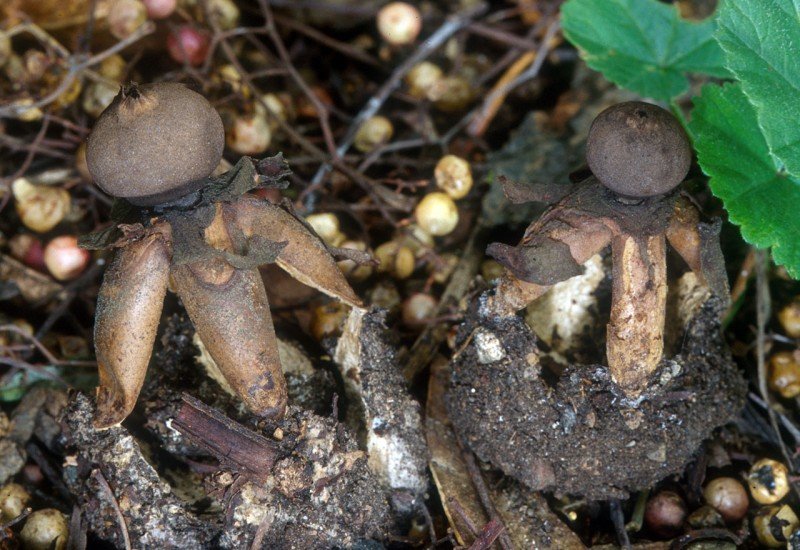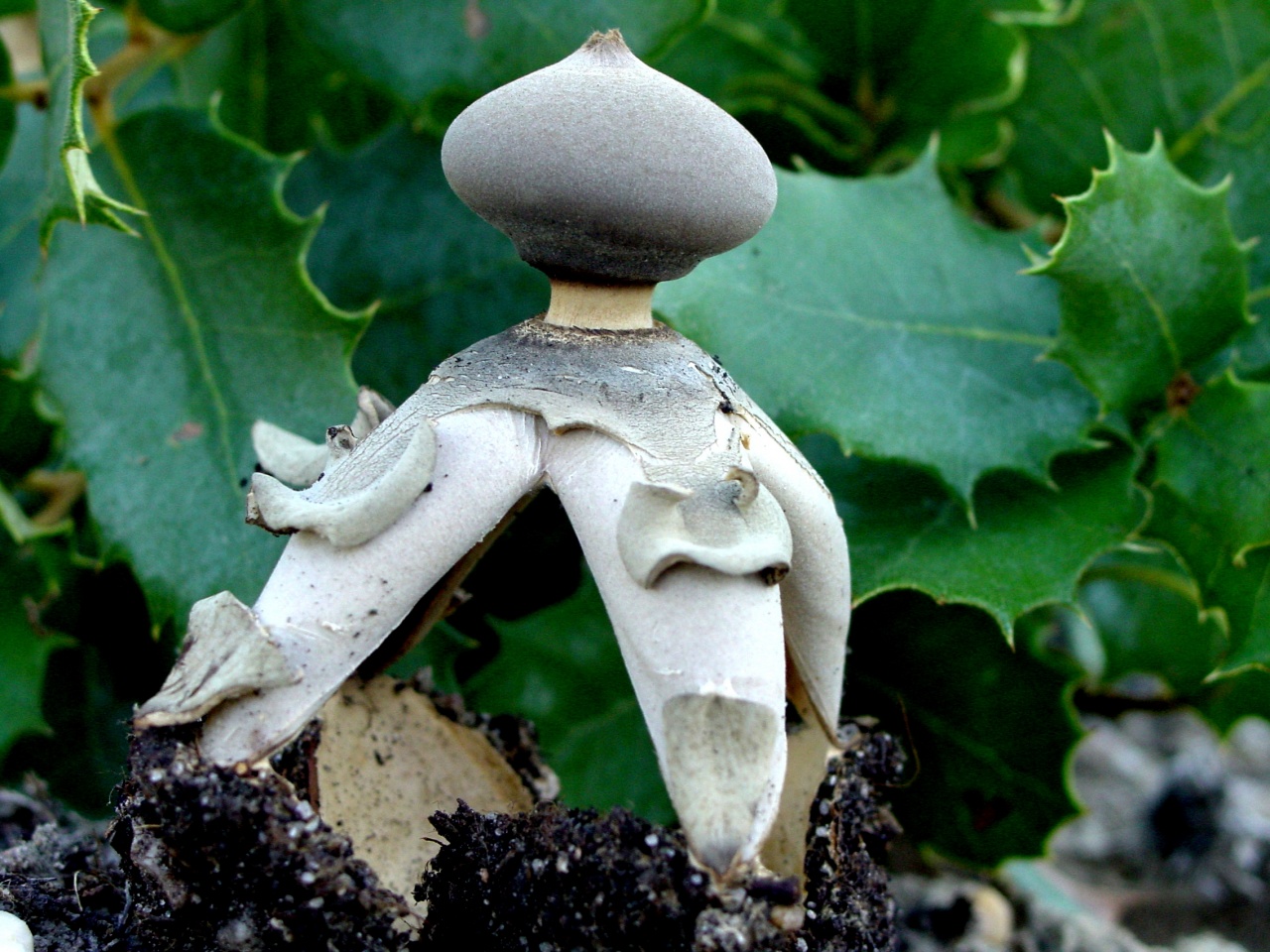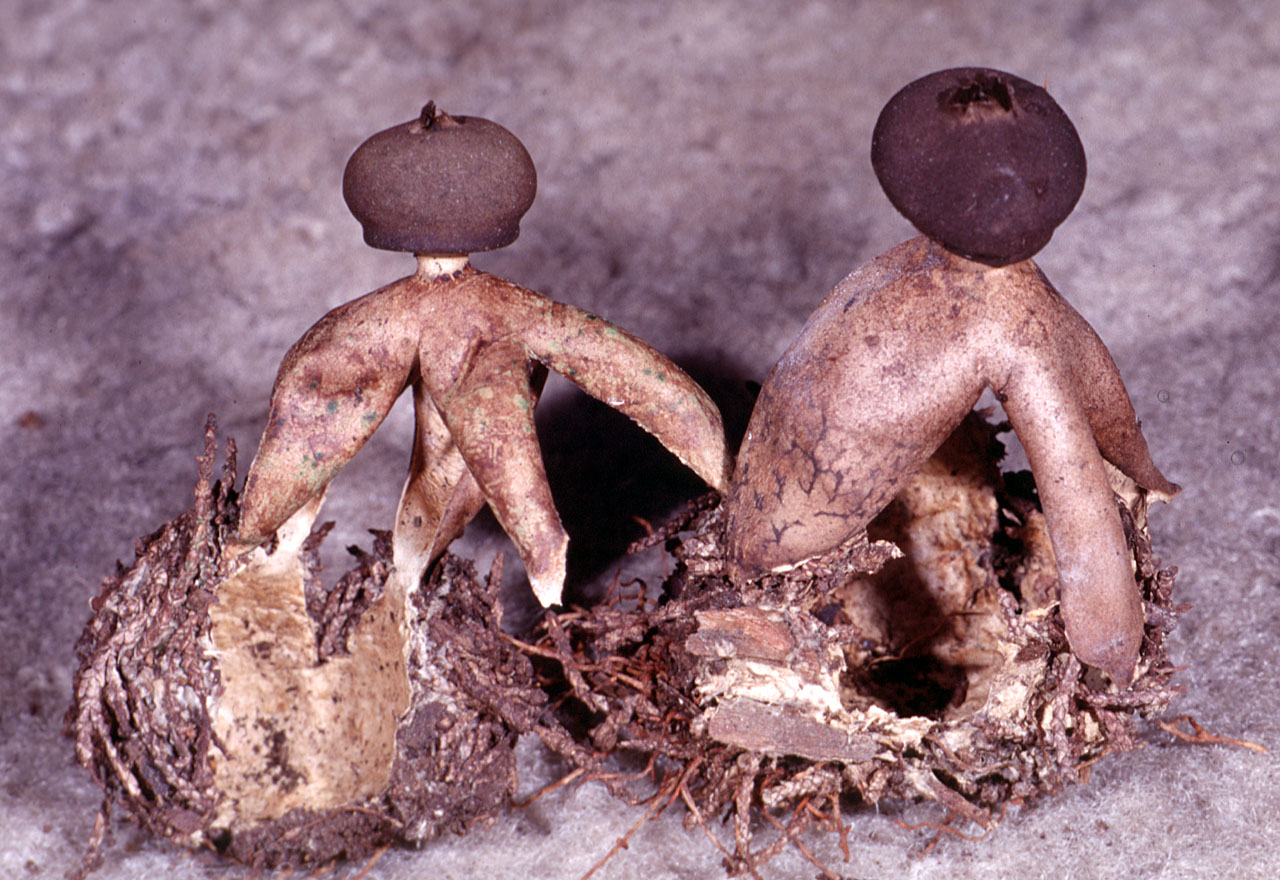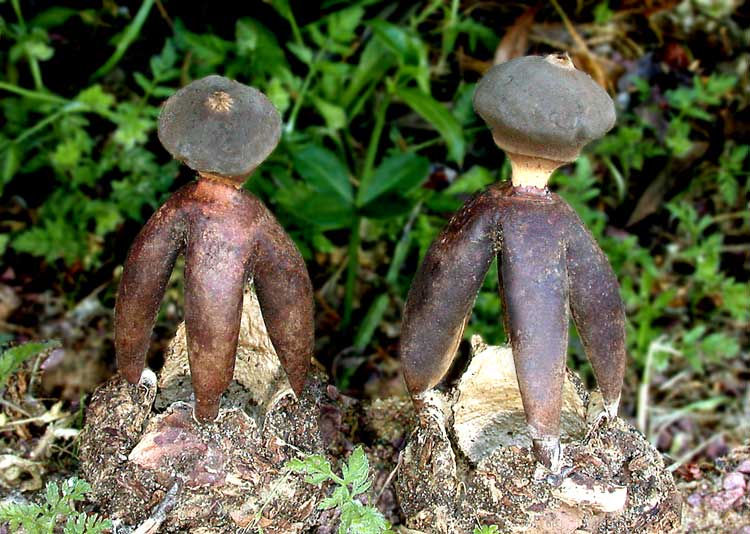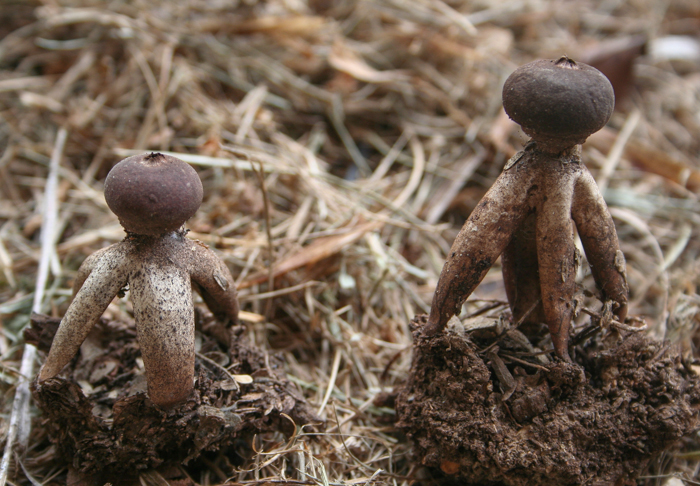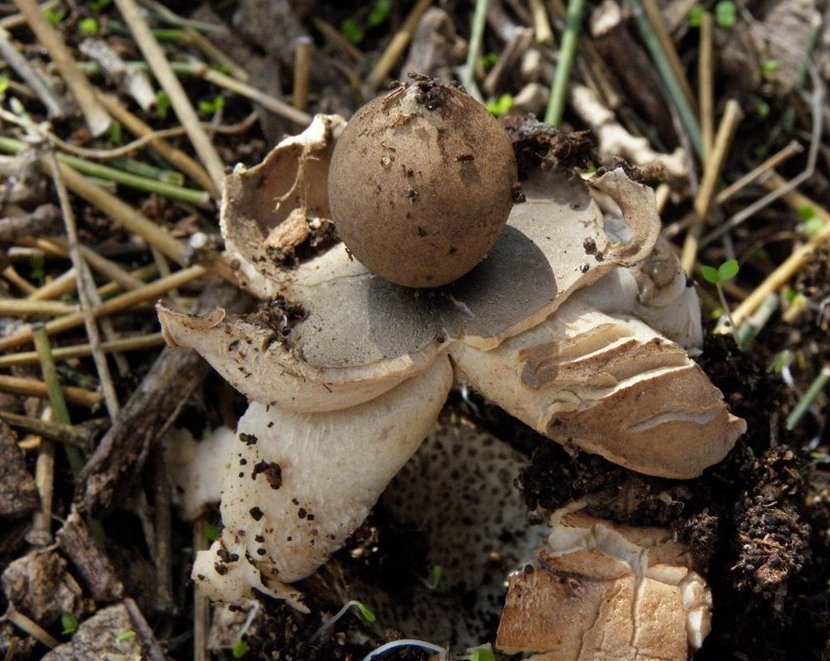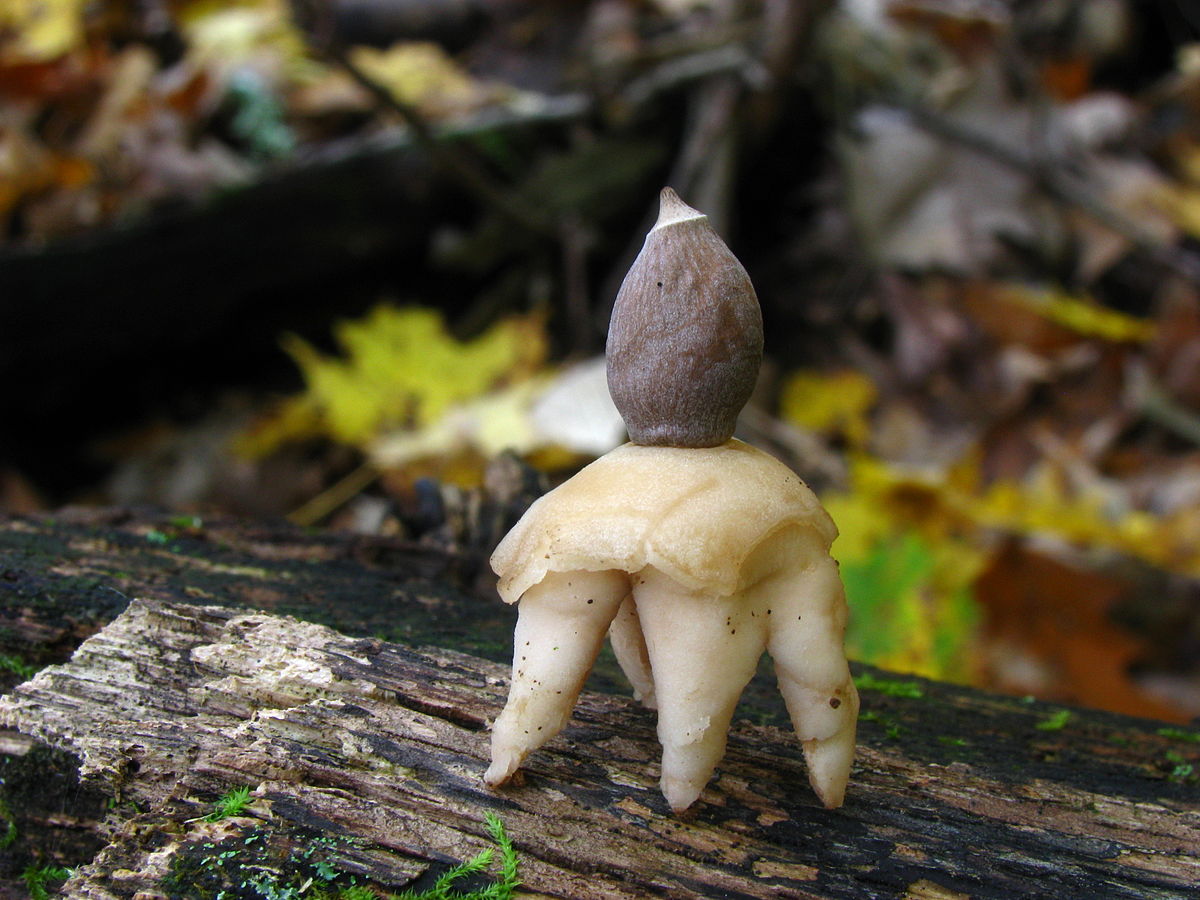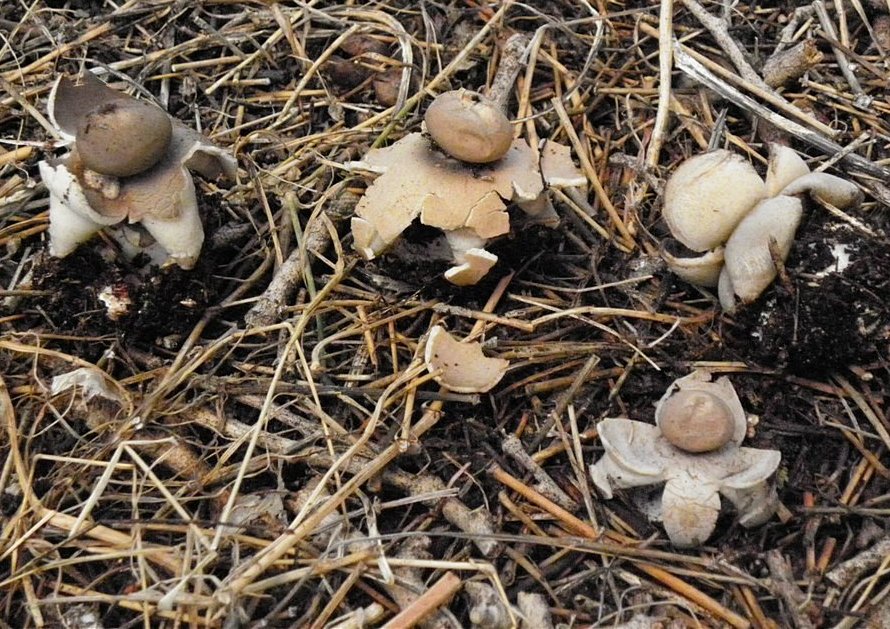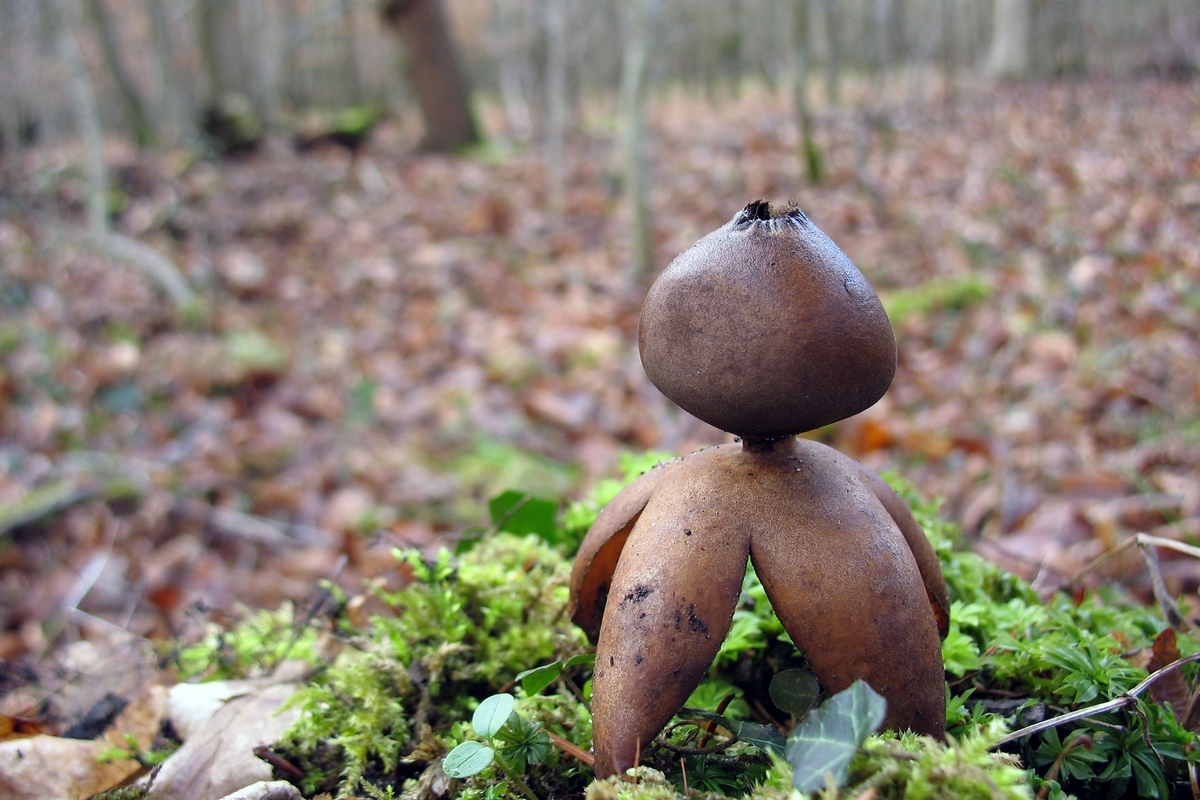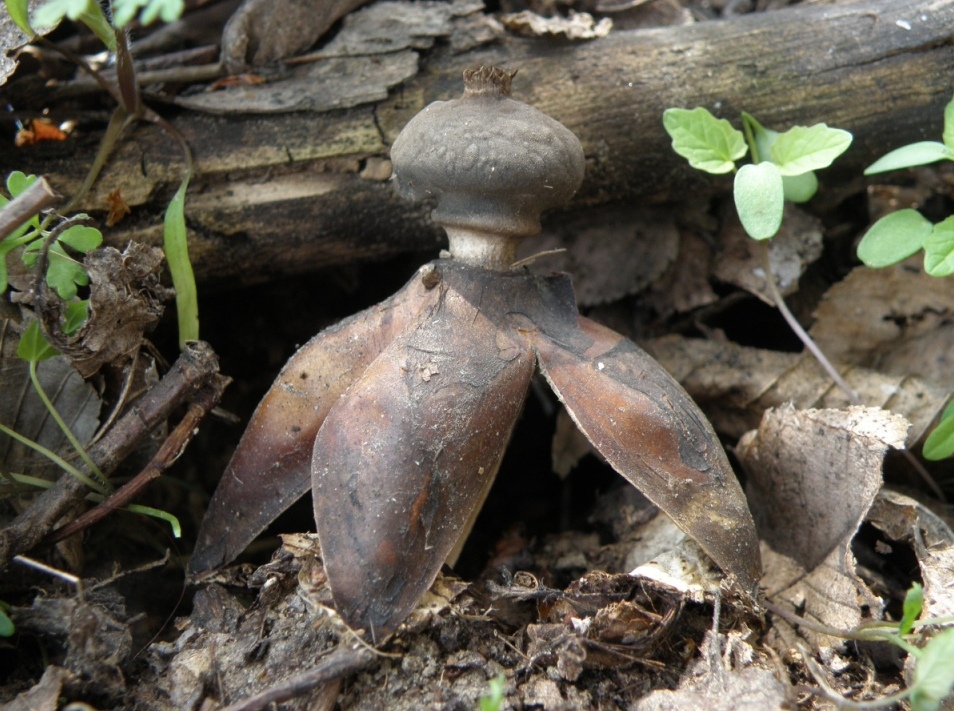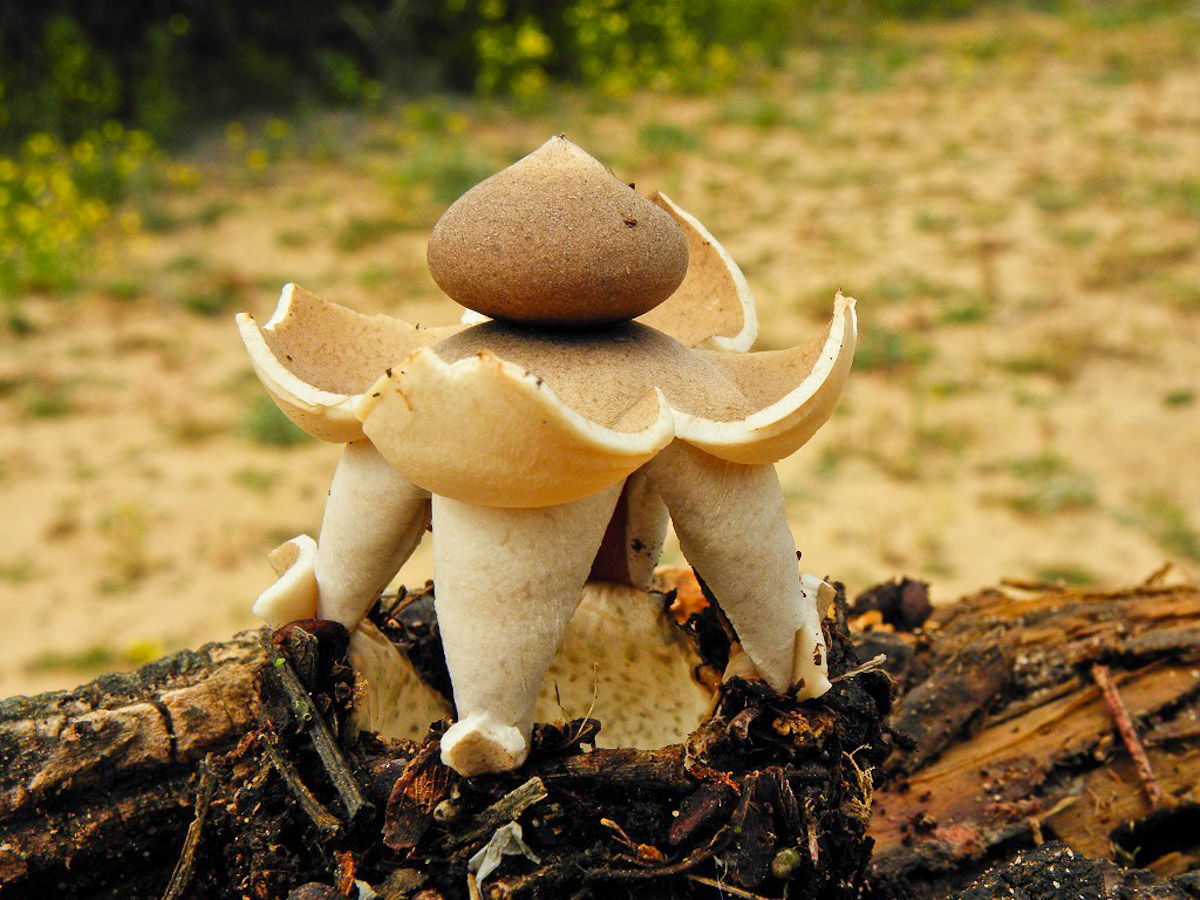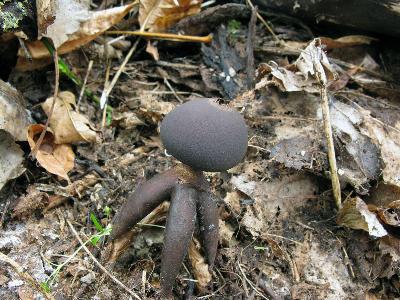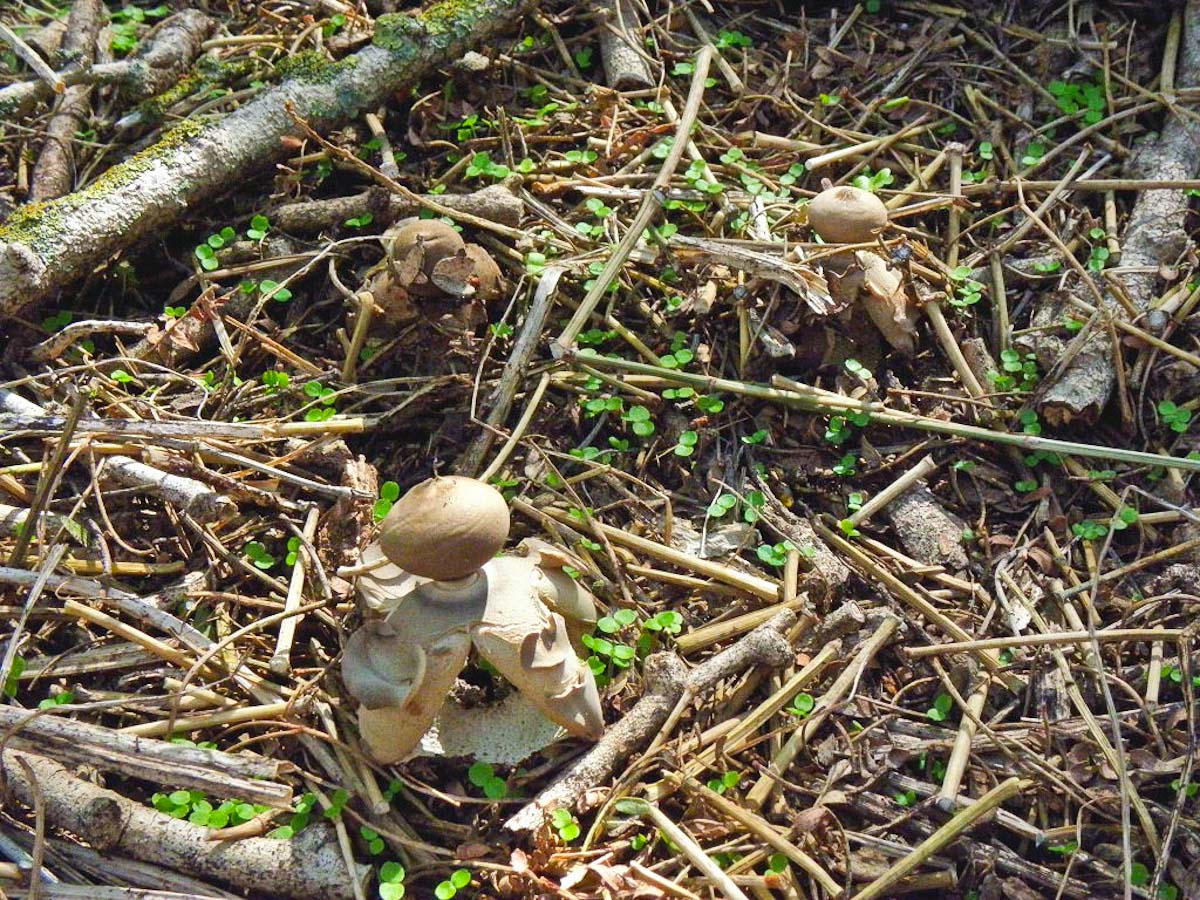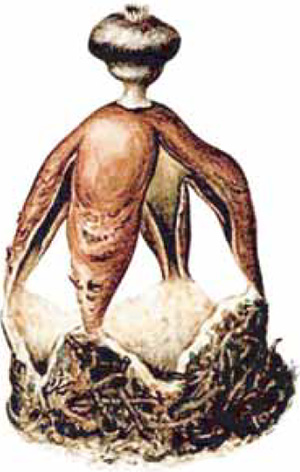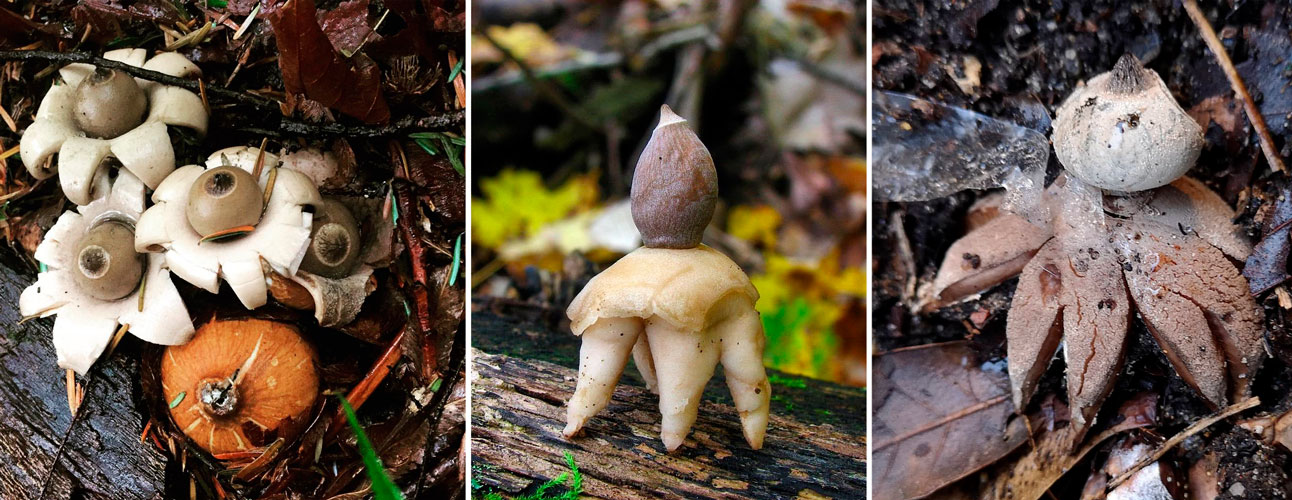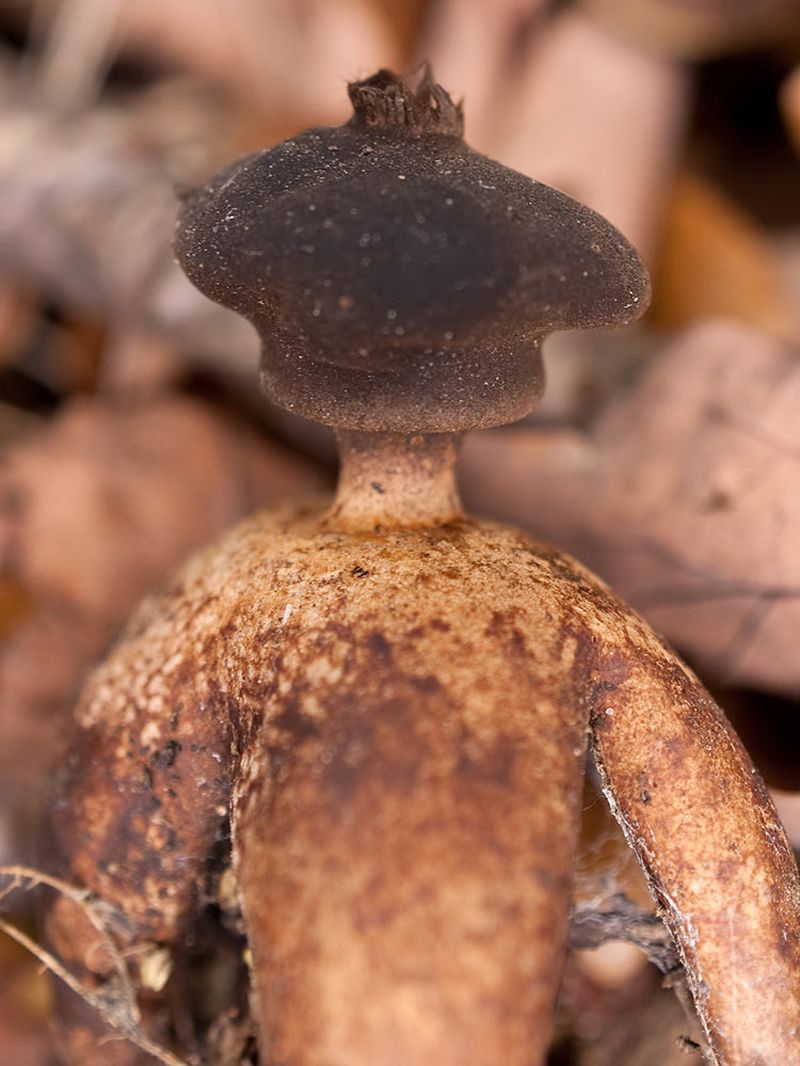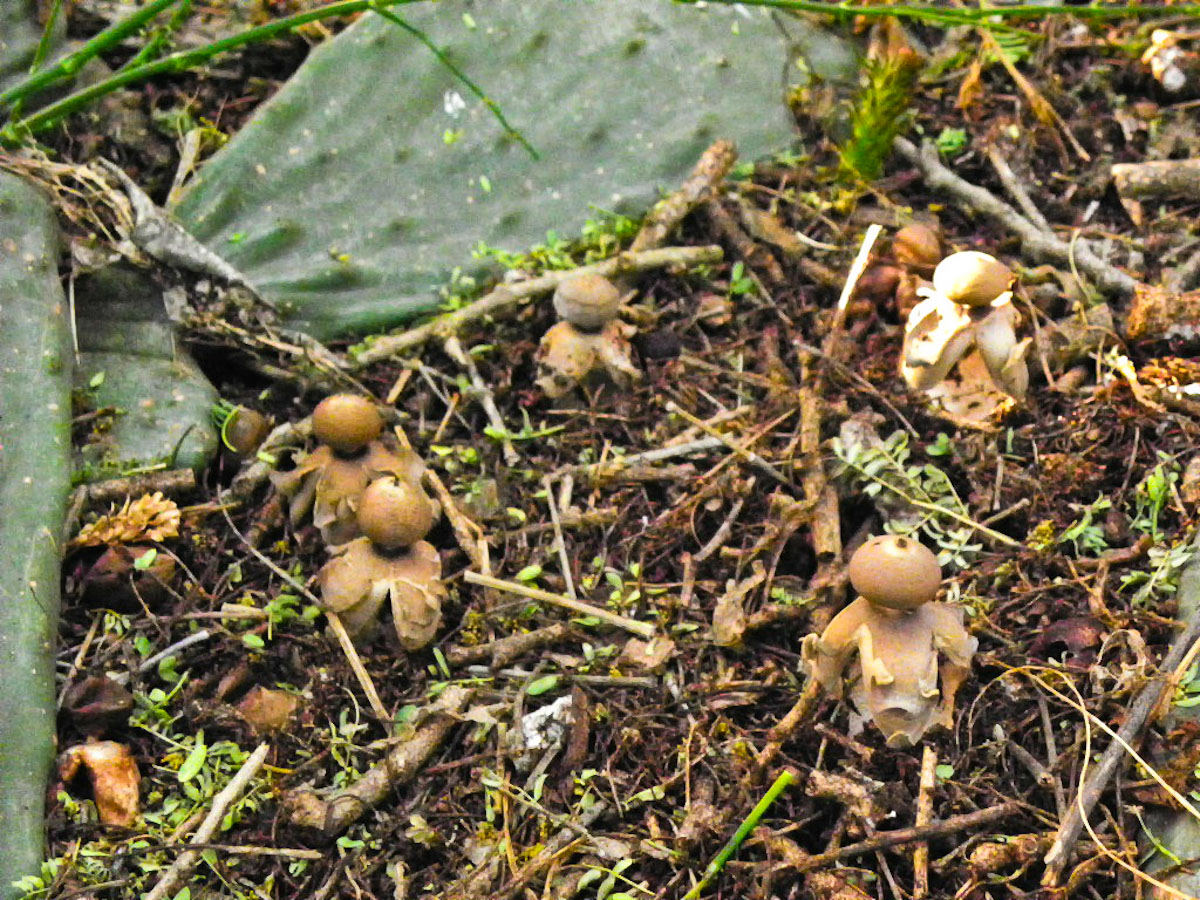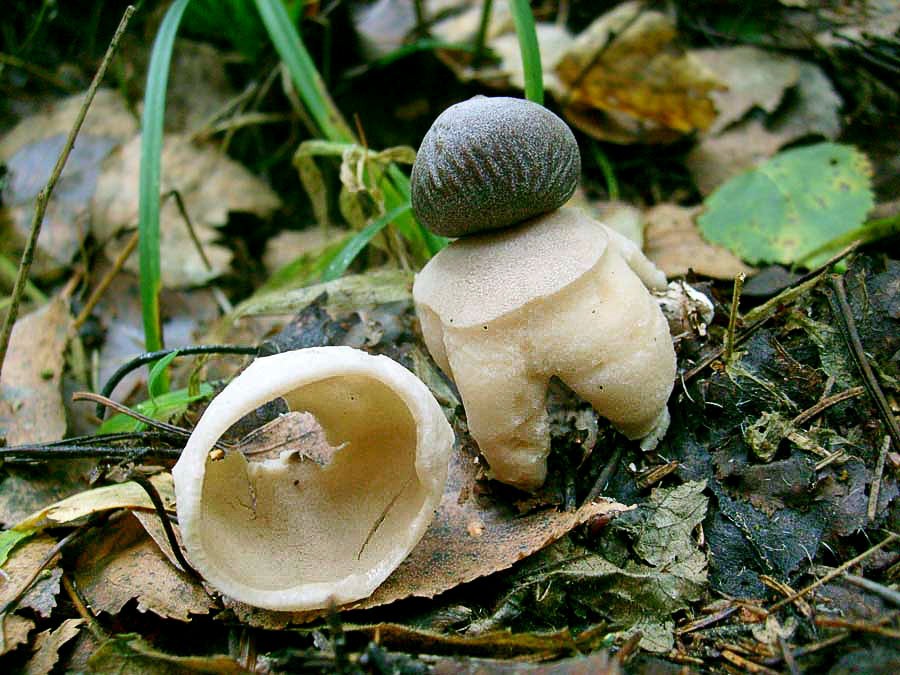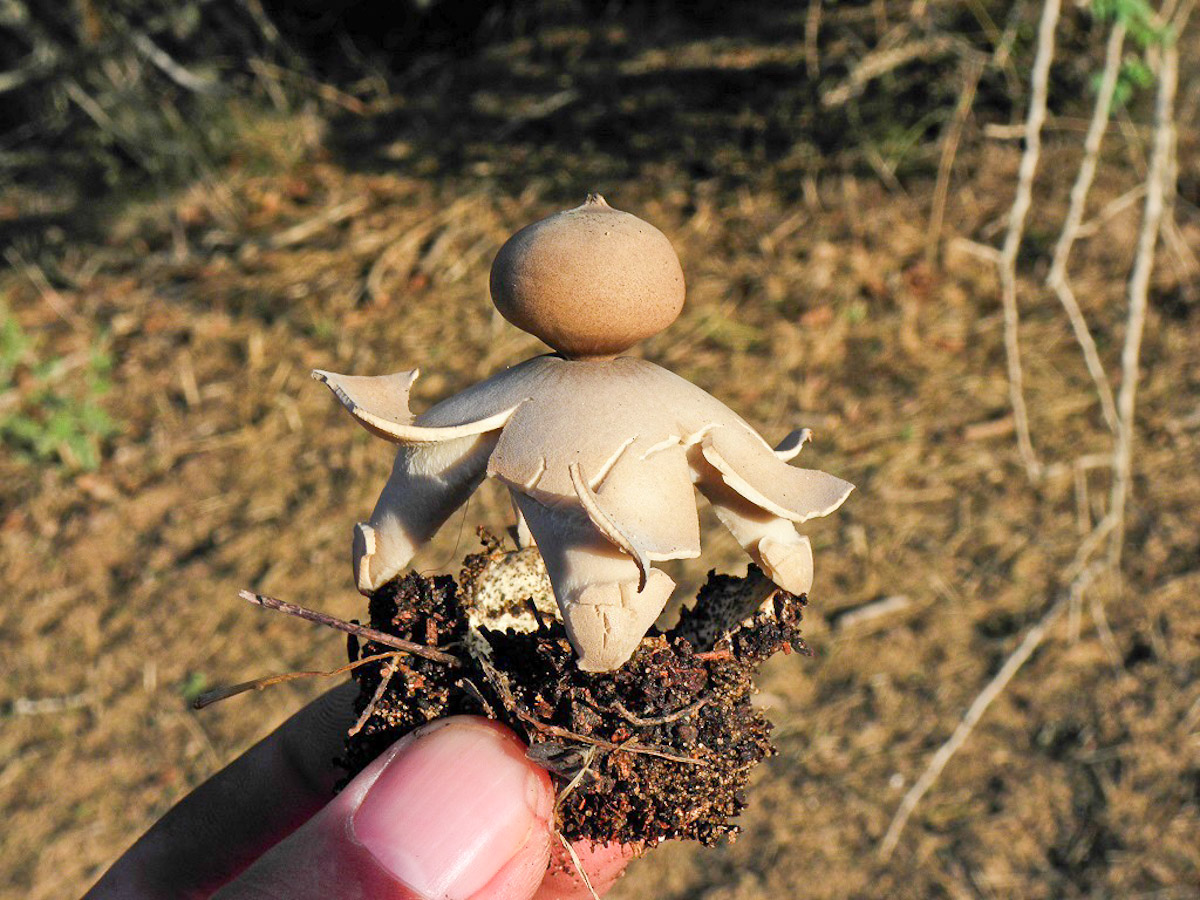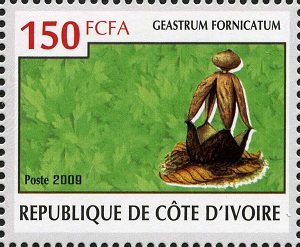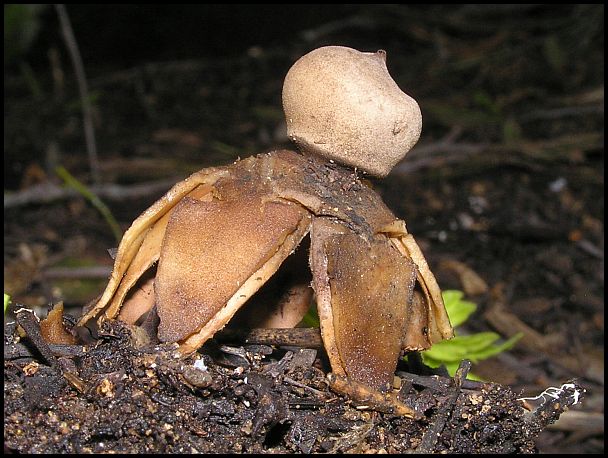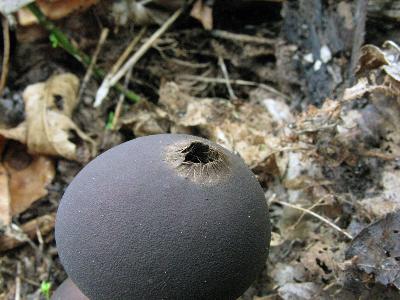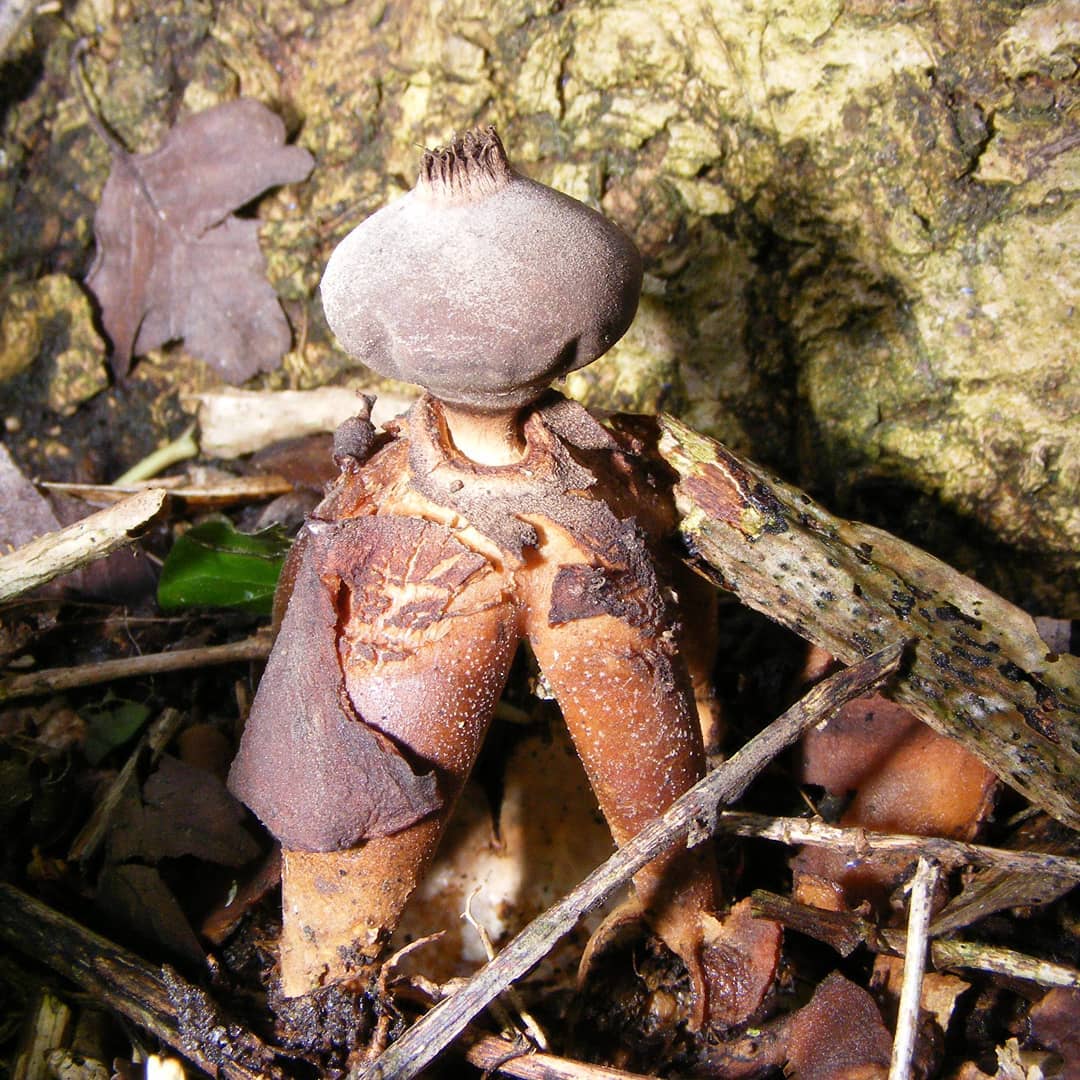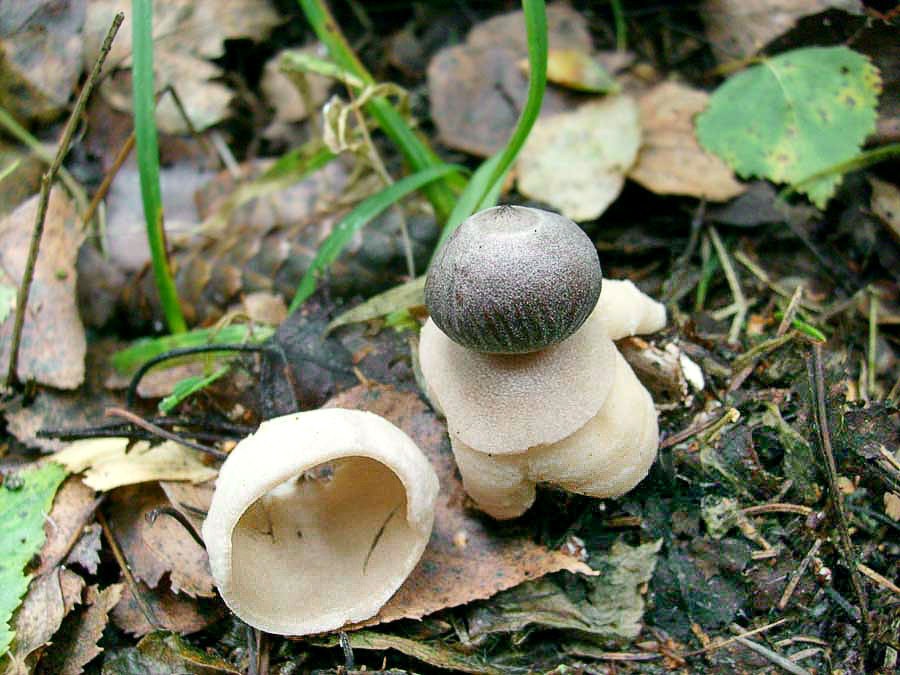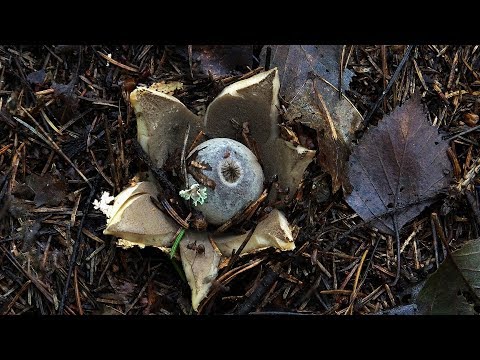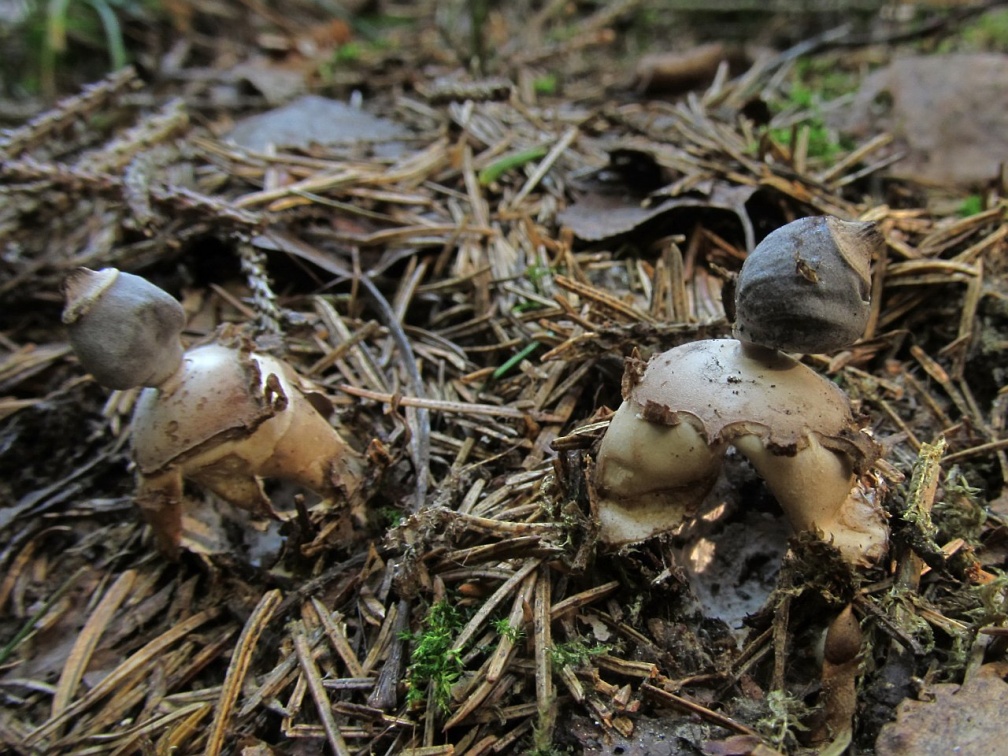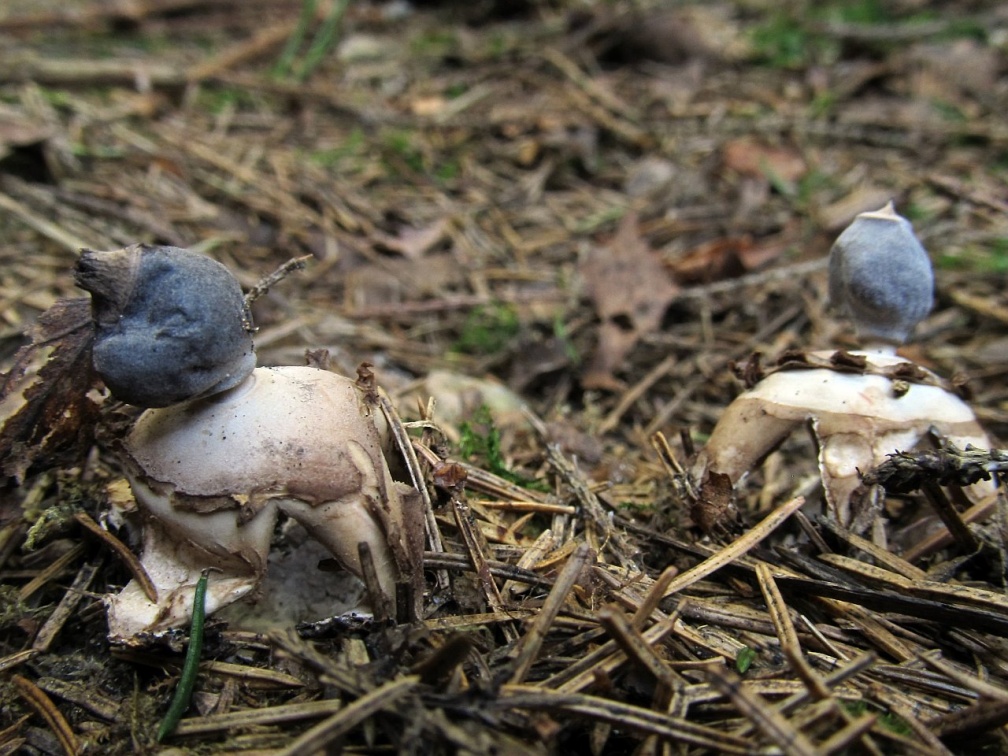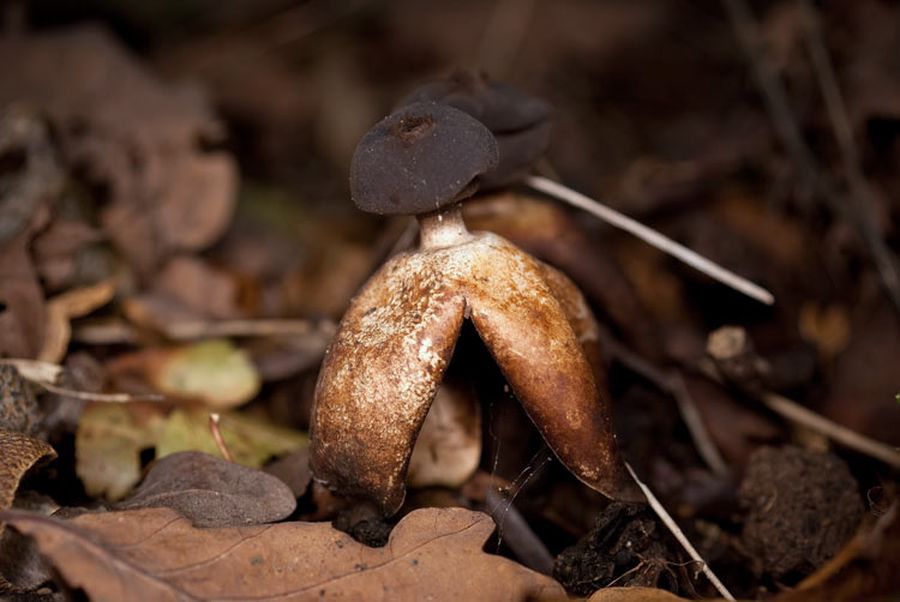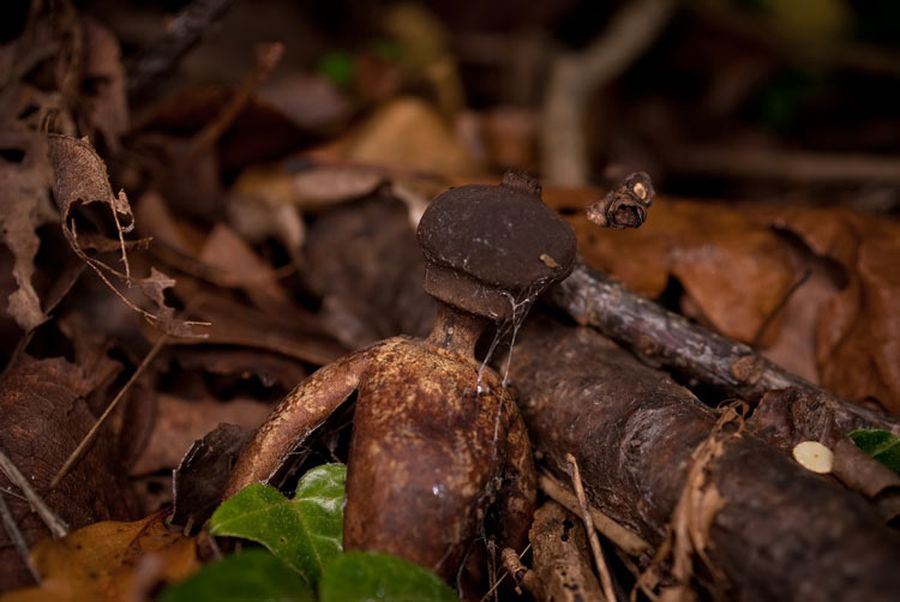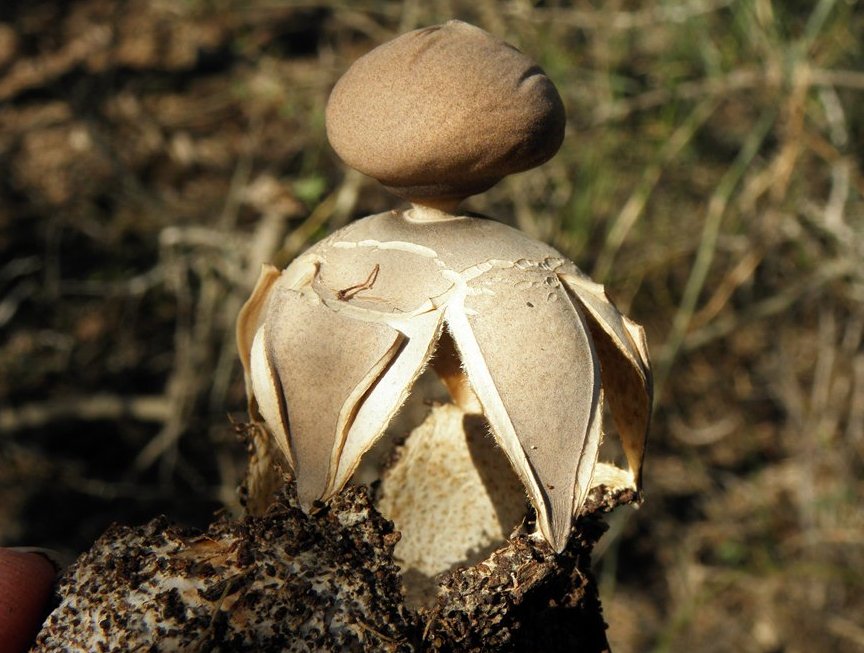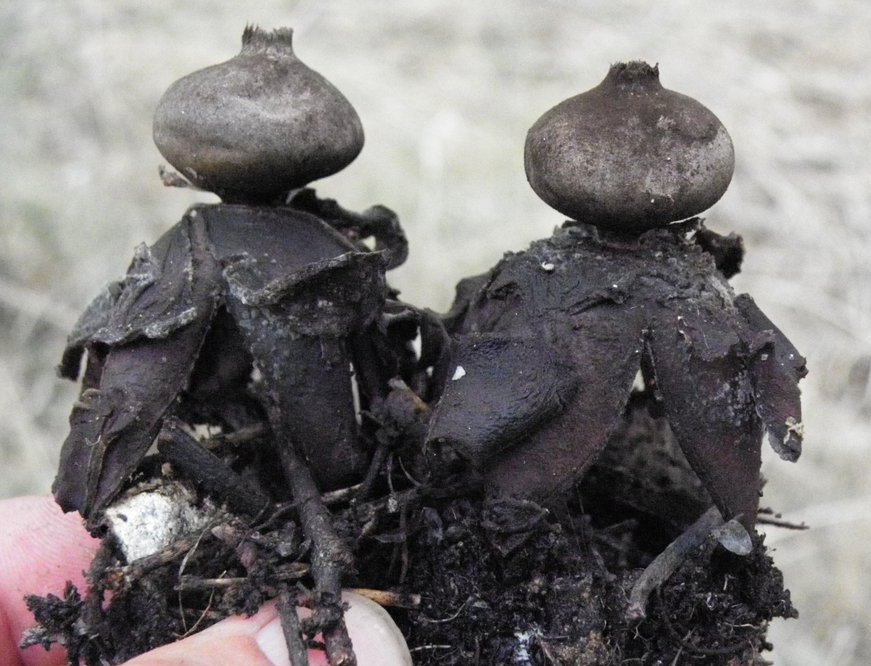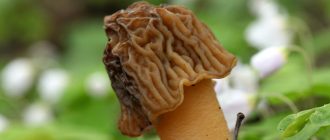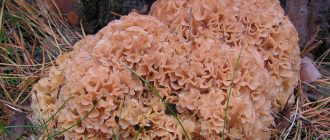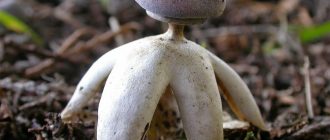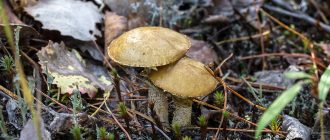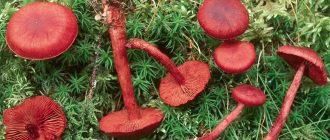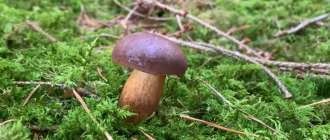Varieties
The Zvezdovik family contains a number of edible and unsuitable for culinary purposes.
Edible
The vaulted starfish, or Geastrum fornicatum, is eaten.
The fruiting body is spherical. The shade is yellow-brown. Partially buried in soil. At the stage of maturity, it cracks into curling blades. The inner part is gray, at the stage of active fruiting it becomes chocolate.
Only young mushrooms are suitable for collection.
The pulp is light; as it grows, it coarsens and turns into a dark brown spore mass.
Suitable for use at a young age, as long as the mushroom retains its spherical appearance. It is used without preliminary heat treatment.
Conditionally edible
It has a low nutritional value, does not possess a pronounced smell and taste, a conditionally edible Schmidel variety, or Geastrum schmidelii.
Fruit body diameter up to 8 cm. The shape is initially round, in a mature mushroom it is stellate inherent in the family. The spore-bearing ball is crowned with a tapered tip.
Grows on desert soils and decayed wood debris in mixed forests. Fruiting in August.
Inedible
- Triple, or Geastrum triplex. The shape of young fruit bodies is rounded with a pointed tubercle, similar to a bulb. Height up to 5 cm, diameter up to 3.5 cm. In a mature mushroom, the body is revealed by a two-layer shell up to 12 cm wide. The shape of the inner center is in the form of a cupped collar under a flattened outer sessile shell. The color at the stage of full maturation is beige or terracotta. Spores are globular, brown. The structure of the outer pulp is compacted, leathery, the inner one is fragile and soft. Grows in deciduous and mixed forest belts. Grows in large groups of coniferous and leaf litter. Fruiting occurs at the end of summer and autumn.
- Striped, or Geastrum striatum. Young, bulbous fruiting bodies are located underground. As it matures, the mushroom shell bursts, dividing the mushroom into pointed blades and a head with a granular structure and a tapered striped tip. The color of an adult specimen is milky. The spores are brown. Grows on wilderness areas, decaying stumps and tree trunks in mixed forests, park areas. More often found under oak and ash trees. Fruiting from summer to autumn.
- Crowned, or Geastrum coronatum. The fruiting body is spherical. When cracked, it is divided into sharp-pointed gray blades with a matte sheen and a central spherical part of a brown tint. Spores are dark brown. Fruiting occurs in autumn. Occurs in gardens and park areas on sandy and clayey soils among grass.
- Fringed, or Geastrum fimbriatum. Initially, the shape of the fruiting body is spherical; at the stage of maturity, the three-layer dense shell breaks into a gray spore-bearing ball and yellow-brown star-like lobes, which twist when exiting the ground. Fruiting from the beginning of August. It grows on alkaline soils in coniferous and deciduous forests in large groups, often with witch's rings.
- Small, or Geastrum minimum. It differs from all in small size. The shape of the fruit body in young mushrooms is spherical. Diameter up to 1.8 cm, unfolded - up to 3.5 cm. Color gray with beige. The apex is crowned with a conical tubercle. The spores are brown. Grows on limestones on steppe and forest edges.
- Black-headed, Geastrum melanocephalum. The shape of young mushrooms is spherical, pear-shaped or bulbous. Width up to 7 cm. Color from milky to brown. Star-shaped blades and a spore-bearing ball with a shaggy surface. Differs in complete exposure of the gleba when the inner shell is destroyed. The pulp is initially firm, becoming fibrous and powdery as it matures, the color is dark brown.Prefers humus soils. It grows in deciduous forest belts among maples and ash trees.
- Four-lobed, or Geastrum quadrifidum. The shape of the fruiting body is initially spherical, up to 2 cm in diameter, in adulthood - up to 5 cm. The peridium consists of 4 layers. The outer mycelium is whitish with a felt structure. Medium smooth, fibrous. Inner white, in a mature mushroom, it breaks into pointed lobes and a central part that is understood upwards. Gleb powdery color, black purple or brown. Grows on sandstones in pine, spruce and deciduous forests. Fruiting occurs in August-October.
Geastrum quadrifidum
- Other names for the mushroom:
- Starfire four-bladed
- Geastrum four-bladed
Synonyms:
- Star wheel four-part
- Geastrum four-bladed
- Earth star four-bladed
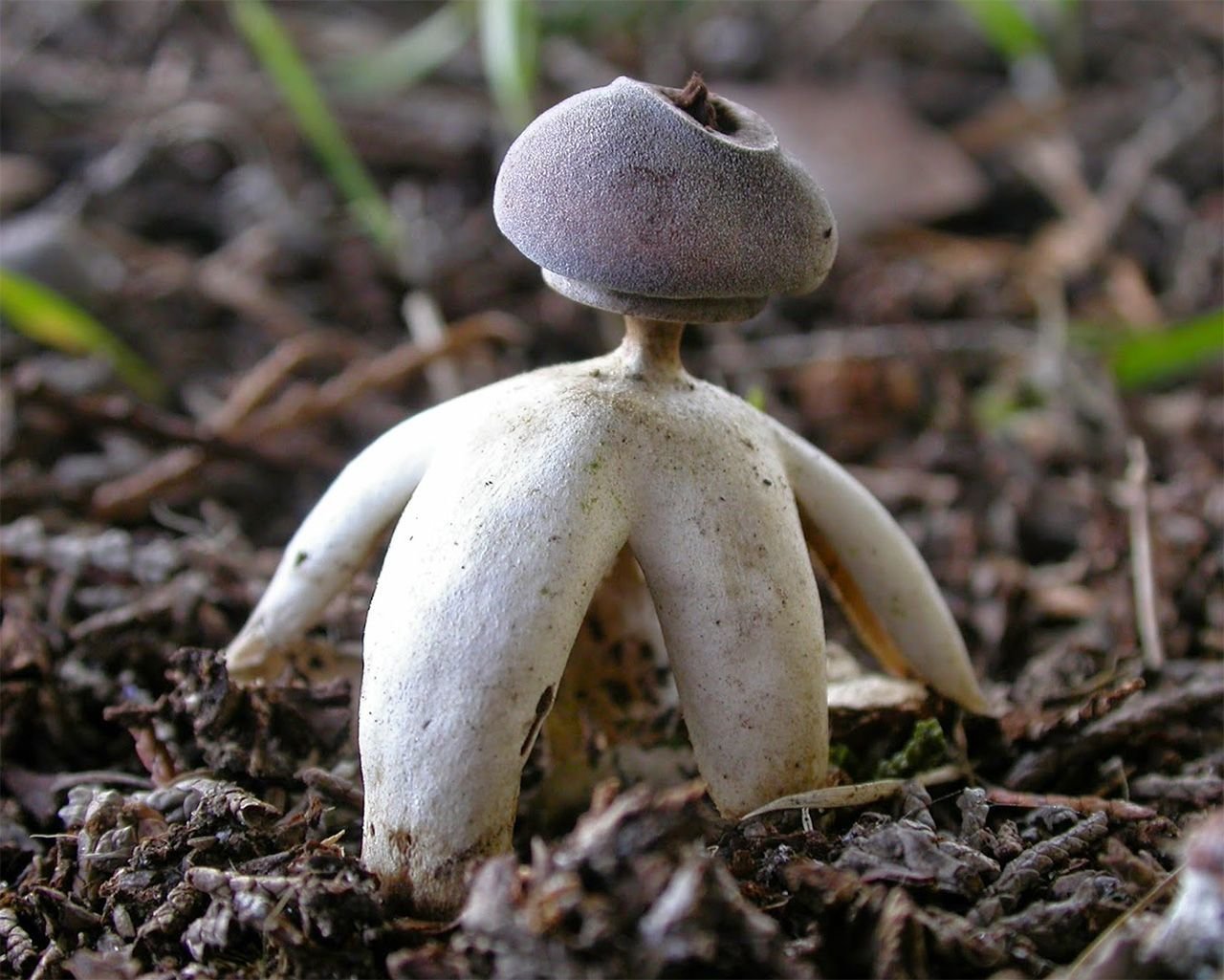 Description
Description
Fruiting bodies are initially closed, spherical, about 2 cm in diameter, covered with a peridium, along the entire surface of which mycelial strands are located; mature - open, 3-5 cm in diameter. Peridium is four-layer, consists of exoperidium and endoperidium. Exoperidium in the form of a bowl, three-layer or two-layer, hard, breaks from top to bottom to the middle into 4 unequal, pointed parts (lobes), bending down, and fruiting bodies rise up on the lobes, as on "legs". The outer mycelial layer is whitish, felt, covered with soil particles, soon disappears. The middle fibrous layer is white or isabella, smooth. The inner fleshy layer is white, also torn into 4 parts, with sharp ends resting on the sharp ends of the blades of the outer layer, soon disappears. The base is convex. The middle rises up together with the inner part of the fruiting body - the gleba. The spherical or oval (ovoid) glebe is covered with endoperidium, 0.9-1.3 cm high and 0.7-1.2 cm wide. At the base with a flattened leg, over which the endoperidium is narrowed and a well-visible rounded protrusion (apophysis) is formed, at the apex it opens with an opening, which is equipped with a low peristome. The peristome is conical, fibrous, with a sharply limited courtyard, smoothly fibrous-ciliate, around which there is a clear ring. The stem is cylindrical or slightly flattened, 1.5-2 mm high and 3 mm thick, whitish. The column is cotton-wool, light brown-gray in section, 4-6 mm long. Its exoperidium ruptures more often by 4, less often by 4-8 unequal pointed lobes, bending downward, which is why the entire fruiting body rises up on the lobes, as on legs.
The leg (in the traditional sense) is missing.
Gleba is powdery when ripe, black-purple to brown. Spores are brownish, light or dark brown.
When pressed, the spores fly in all directions. Spores are olive brown.
HABITAT AND GROWTH TIME
The four-part starfish grows mostly on sandy soil in deciduous, mixed and coniferous - pine, spruce, pine-spruce and spruce-deciduous forests (among the fallen needles), sometimes in abandoned anthills - from August to October, rarely. Recorded in Russia (European part, Caucasus and Eastern Siberia), Europe and North America. We found it southeast of St. Petersburg in a mixed forest (birch and spruce) under an old spruce on needles in early October (the mushrooms grew as a family).
TWINS
The four-part starfish is very peculiar in appearance and is strikingly different from mushrooms of other genera and families. Similar to other starfish, for example, the Vaulted starfish (Geastrum fornicatum), whose exoperidium splits into two layers: the outer one with 4-5 short, obtuse lobes and the inner, convex in the center, also with 4-5 lobes; on Zvezdovik crowned (Geastrum coronatum) with leathery, smooth exoperidium, splitting into 7-10 gray-brown pointed lobes; on Fringed Starfish (Geastrum fimbriatum) with exoperidium, which is torn by half or by 2/3 - by 5-10 (less often up to 15) unequal blades; on Zvezdovik striped (G. striatum) with exoperidium, bursting into 6-9 lobes, and light gray gleb; on the small Shmiela Starfish (G. schmidelii) with an exoperidium forming 5-8 lobes, and a gleba with a beak-shaped grooved striped nose; on Zvezdovik triple (Geastrum triplex) with a fibrous hole at the top of a gray-brown block.
It is confined to the soils of deciduous and coniferous forests.
Description
Young fruit bodies are underground, almost spherical or flattened, with ingrown litter particles, brownish-yellow. When the exoperidium opens, it breaks star-like into 4-5 (7) rays, 3-10.5 cm in height. The rays are not hygroscopic, erect, with "arches" lifting the endoperidium above the ground. The ends of the rays are adherent to the mycelial layer of exoperidium, which remains on the ground. When straightening exoperidia up to 15.5 cm in diameter. The mycelial layer of exoperidium is thick, with ingrowing litter particles, durable, fawn on the inside, then turns brown. The fibrous layer is leathery, from the side of the endoperidium, first covered with a pseudoparenchymal layer, then exposed, in old fungi it is completely naked, dirty gray-brown from the side of the mycelial layer whitish-fawn, then brown. The inner (pseudoparenchymal) layer (covering the exoperidium from the side hidden in young fruiting bodies, then showing) is at first whitish, then darkens to brownish, cracks and disappears with age.
The endoperidium surrounding the glebe is raised above the "star" on a noticeable pedunculate process, usually spherical, about 1–2 cm in diameter. The peristome is mastoid at first, then conical or short tubular.
Spores in the mass are dark brown, spherical, with a finely warty surface, 3.5-4.2 µm in diameter. Capillary hyphae are thick-walled, up to 10 microns thick, with thin ends, yellowish-brown.
It has no nutritional value, it is considered an inedible mushroom.
Similar views edit code
- Geastrum quadrifidum Pers., 1794 - The four-bladed starfish is distinguished by its significantly smaller size and well-circumscribed peristome. After overwintering, the exoperidia of the vaulted starlet remains brown, and in the four-bladed, it turns white. The endoperidium of the vaulted starlet under the magnifying glass is hairy, and in the four-lobed one it is smooth.
- Geastrum dissimile Bottomley, 1948 - described from South Africa, is distinguished by a clearly limited furrowed pinnate, as well as smaller in size.
- Geastrum welwitschii Mont., 1856 - it differs even before opening by the fruiting bodies that appear above the ground and the outer layer of exoperidium, into which litter particles do not grow.
Description of the vaulted starlet.
At a young age, the fruiting bodies of the vaulted starfish are underground. Their shape is spherical or flattened. Young mushrooms have ingrown litter particles. The color of the fruit body is brownish-fawn.

Outside, the fruit body is covered with a shell - exoperidium, which eventually opens in the form of a star with 4 or 7 rays. The length of these rays is 3-10.5 centimeters. The beams are erect, their ends grow to the mycelial layer of the exoperidium, which is underground.
The mycelial layer is thick, its inner side is first pale yellow, and then turns brown. The fibrous layer is leathery, old mushrooms become glabrous. The inner layer of the fungus, called pseudoparenchymal, has a whitish color, then turns brown, cracks and disappears.

The pulp of the mushroom is surrounded by endoperidium, it rises above the "star". The endoperidium form is most often spherical. The diameter of the ball is 1-2 centimeters. Inside the ball there are spherical spores with a finely warty surface. The color of the spore powder is dark brown. As it grows, the mushroom pulp quickly becomes coarse, when it ripens, almost all of it is converted into a brown mass.
Geastrum quadrifidum
- Other names for the mushroom:
- Starfire four-bladed
- Star wheel four-part
Synonyms:
- Star wheel four-part
- Geastrum four-bladed
- Earth star four-bladed
 Description
Description
Fruiting bodies are initially closed, spherical, about 2 cm in diameter, covered with a peridium, along the entire surface of which mycelial strands are located; mature - open, 3-5 cm in diameter. Peridium is four-layer, consists of exoperidium and endoperidium.Exoperidium in the form of a bowl, three-layer or two-layer, hard, breaks from top to bottom to the middle into 4 unequal, pointed parts (lobes), bending down, and fruiting bodies rise up on the lobes, as on "legs". The outer mycelial layer is whitish, felt, covered with soil particles, soon disappears. The middle fibrous layer is white or isabella, smooth. The inner fleshy layer is white, also torn into 4 parts, with sharp ends resting on the sharp ends of the blades of the outer layer, soon disappears. The base is convex. The middle rises up together with the inner part of the fruiting body - the gleba. The spherical or oval (ovoid) glebe is covered with endoperidium, 0.9-1.3 cm high and 0.7-1.2 cm wide. At the base with a flattened leg, over which the endoperidium is narrowed and a well-visible rounded protrusion (apophysis) is formed, at the apex it opens with an opening, which is equipped with a low peristome. The peristome is conical, fibrous, with a sharply limited courtyard, smoothly fibrous-ciliate, around which there is a clear ring. The stem is cylindrical or slightly flattened, 1.5-2 mm high and 3 mm thick, whitish. The column is cotton-wool, light brown-gray in section, 4-6 mm long. Its exoperidium ruptures more often by 4, less often by 4-8 unequal pointed lobes, bending downward, which is why the entire fruiting body rises up on the lobes, as on legs.
The leg (in the traditional sense) is missing.
Gleba is powdery when ripe, black-purple to brown. Spores are brownish, light or dark brown.
When pressed, the spores fly in all directions. Spores are olive brown.
HABITAT AND GROWTH TIME
Geastrum four-lobed grows mostly on sandy soil in deciduous, mixed and coniferous - pine, spruce, pine-spruce and spruce-deciduous forests (among fallen needles), sometimes in abandoned anthills - from August to October, rarely. Recorded in Russia (European part, Caucasus and Eastern Siberia), Europe and North America. We found it southeast of St. Petersburg in a mixed forest (birch and spruce) under an old spruce on needles in early October (the mushrooms grew as a family).
TWINS
Geastrum four-bladed is very peculiar in appearance and is strikingly different from mushrooms of other genera and families. Similar to other starfish, for example, the Vaulted starfish (Geastrum fornicatum), whose exoperidium splits into two layers: the outer one with 4-5 short, obtuse lobes and the inner, convex in the center, also with 4-5 lobes; on Zvezdovik crowned (Geastrum coronatum) with leathery, smooth exoperidium, splitting into 7-10 gray-brown pointed lobes; on Fringed Starfish (Geastrum fimbriatum) with exoperidium, which is torn by half or by 2/3 - by 5-10 (less often up to 15) unequal blades; on Zvezdovik striped (G. striatum) with exoperidium, bursting into 6-9 lobes, and light gray gleb; on the small Shmiela Starfish (G. schmidelii) with an exoperidium forming 5-8 lobes, and a gleba with a beak-shaped grooved striped nose; on Zvezdovik triple (Geastrum triplex) with a fibrous hole at the top of a gray-brown block.
It is confined to the soils of deciduous and coniferous forests.
Habitat
Zvezdovik is a rare occurrence in most of Russia. It is found both in warmer regions, for example, in the Caucasus, and in the forests of the temperate zone of the European part, Eastern Siberia, as well as in Europe and in the southern states of North America. These are wild-growing eukaryotes - no one is breeding them.
The habitat of earthen stars is coniferous and mixed forests with a predominance of spruces, pines, oaks, birches, aspens, and small shrubs. Mushrooms love to settle on the banks of reservoirs in secluded places. They grow up with whole families, or "witch" circles.
By the way of feeding, these mushrooms are saprotrophs.
The ripening period for the spores occurs in late August and early October.In some species, in good weather, it lasts until the end of autumn.
Mushroom application
The beneficial properties of the starfish have led to its use in medicine. Compounds in the composition of the tissues of the fruiting body help to stop blood and have an antiseptic effect, therefore, different medicines are made on the basis of this type.
Preparations based on the earthen asterisk are included in the complex of anticancer therapy.
In some cases, the opened petals after rupture of the membrane can be used as a plaster to stop blood and quickly heal small scratches and cuts.
Description of blackhead starfish
Young black-headed starfish have pear-shaped, spherical or bulbous fruiting bodies. The diameter of the fruiting body is 4-7 centimeters. The mushroom is pumped in with a sharp nose, the length of which reaches 2 centimeters. The color of the spout can be white or brown.
The outer shell of the fungus, called exoperidium, fuses with its inner shell, endoperidium. The main feature of the black-headed starlet is the destruction of endoperidium during the maturation of the fungus. As a result, the gleb is completely exposed.
The fungus can develop imperceptibly, and can partially protrude above the surface. When the shell disintegrates, 4-6 or 5-7 lobes are formed from it. There is information that there are specimens with 14 blades. These blades spread out on the ground or rise to a globular head.

The flesh of the black-headed starfish is at first dense, it consists of spores and capillaries (thin fibers). When the mushroom ripens, the pulp becomes slightly fibrous, powdery. The color of the pulp is dark brown. Capillation helps to loosen the spore mass. Capillaries are hygroscopic, they cause spores to move, causing them to spray.
Growing places of black-headed earthen stars
These mushrooms live in humus soils. You can find black-headed earthen stars in deciduous forests, gardens, forest parks. They prefer ash and maple plantations.
Black-headed starfish are not very common, even rare. They choose areas with warm climates. These mushrooms grow in European and Central Asian forests. For example, they are known in Switzerland, Austria, Hungary, Germany. In Russia, north of the Moscow region, these mushrooms are not found.

The number of black-headed starfish and measures for the protection of these mushrooms
This is a rare species. Black-headed starfish have a narrow range. Their habitats are destroyed under the influence of anthropogenic factors - people cut down forests, change the structure of the forest floor, and the like.
These mushrooms are protected in certain areas. To preserve the species, constant monitoring of the population, the search for new habitats and the observance of the conservation regime are necessary.
The similarity of the black-headed starlet with other mushrooms
Due to the large size of this mushroom, the presence of a hairy ball and blades, the black-headed earthen star is difficult to confuse with other starfish.

Kindred of the blackhead star
Small starfish is an inedible mushroom. The development of fruiting bodies occurs underground, their shape is initially spherical, with a diameter of no more than 1.8 centimeters. The upper shell of the mushroom breaks into 6-12 rays, and the mushroom becomes like a star.
The color of the rays is silvery-beige. Small starfish grow on forest edges, clearings and in the steppes. They choose calcareous soils as a substrate.
The shape of the fruit bodies is at first spherical, over time the rigid shell breaks and diverges to the sides, like a star. As the fruiting body emerges from the ground, individual rays are twisted. The inner part is spherical, without a leg, covered with a paper-thin shell. The pulp of this mushroom is tough, without a pronounced smell and taste.
Fringed starlets grow in groups or "witch rings". Fruiting occurs in autumn.They are mainly found on alkaline soil, under coniferous or deciduous trees.

Sack-shaped star gear: description and properties
- Family: Earth stars (Geastraceae).
- Synonyms: sack-shaped starfish.
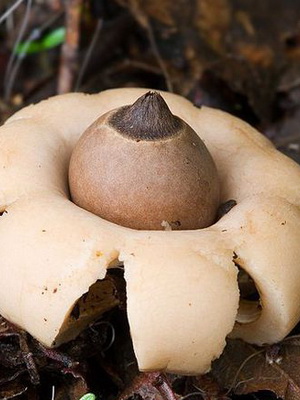

Description. Young fruiting bodies, as they ripen, come to the surface of the soil. They are spherical, bulbous or almost bottle-shaped, with a coracoid tubercle, 0.5-3 X 0.6-3.5 cm. Sometimes 2-3 fruiting bodies grow tightly pressed against each other. The surface is smooth or finely wrinkled, yellowish to pale brown. When ripe, the outer shell (exoperidium) opens up to about half the radius into 3-12 (usually 5-9) rays of different shapes. The beams are often bent in the form of a pouch under the disk of the outer shell. The width of the open mushroom is 1-5 cm, sometimes (with horizontally open rays) it reaches 10 cm. The upper surface of the rays is at first whitish, then pale yellow, nut-brown, soon often falls off, but sometimes remains. The fibrous layer deeper is papery and off-white. The lower, ground surface of the rays is thick, sometimes with longitudinal cracks, velvety, yellowish or brownish on the outside, beige or whitish on the inside.
The spore sac is usually sessile or with a very short stem, spherical, 0.5-2 cm, smooth, light, beige, brownish-gray. The hole for the exit of spores is clearly defined. Mature spore mass is brown, powdery.

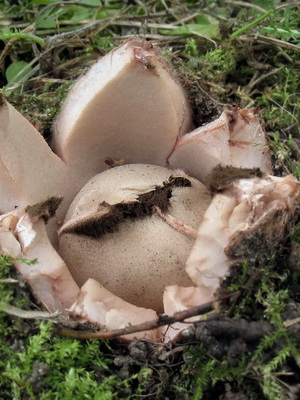
Saccular starfish prefers rich soils, grows on decayed wood in deciduous, deciduous and mixed forests, prefers oak forests. Distributed in the southern forest and forest-steppe zone of the European part of Russia, rare everywhere.
Similar species. It differs well from other earthen stars by a clear wide "outline" around the central hole on the spore-bearing sac.
Pharmacological and medical properties. A β-glucan-protein complex recently isolated from G. saccatum has shown anti-inflammatory, antioxidant and cytotoxic (antitumor) activity. It is assumed that the mechanism of anti-inflammatory action is based on the inhibition of the enzymes nitrinoxide synthetase and cyclooxygenase.
Culinary recommendations. Inedible due to its bitter pulp.
Features of appearance
A mushroom such as starfish, in addition to its main name, is also known as geastrum or earth star. The fruit body grows under the surface of the earth, forming a kind of sac. In the process of growth, the cap of the mushroom comes out, making its way outward, while its surface bursts, due to which the wrapped ends are formed. That is, a ripe mushroom with its external characteristics strongly resembles a star with several spongy rays framing the central part.
The inner part of the star-like geastrum hides a spore-bearing body under it, which has a characteristic geometric shape (often oval or spherical). The top of the part of the fungus, in which the spores mature, has the thinnest protective coating and is bordered by protrusions covered with small cilia. In this form, the fruit part remains until ripening. Over time, the rays darken. They often disappear.
Features of the appearance of earthen stars directly depend on the subspecies. On average, the size of the cap does not exceed 40 mm in diameter, the size of the open star-like part ranges from 30 to 150 mm, the spherical body of the spore-bearing part reaches 13-15 mm in height, and no more than 10-12 mm in width.
At the beginning of development, eukarite, as a rule, has a light color in all its parts (the color varies from fine white to deep red or brownish). As the mushroom matures, the color of the fruiting body darkens. Starfish spores are brown or fawn.
scutellinia thyroid - description, toxicity of the fungus
Varieties
All representatives of the star family are divided into 2 large groups: conditionally edible and inedible.Vaulted eukaryotes belong to the first species, because in theory they can be used for food, although the flesh of the young geastrum is tasteless and odorless.
At the end of the life cycle, starfish are unsuitable for cooking any dishes, regardless of the species.
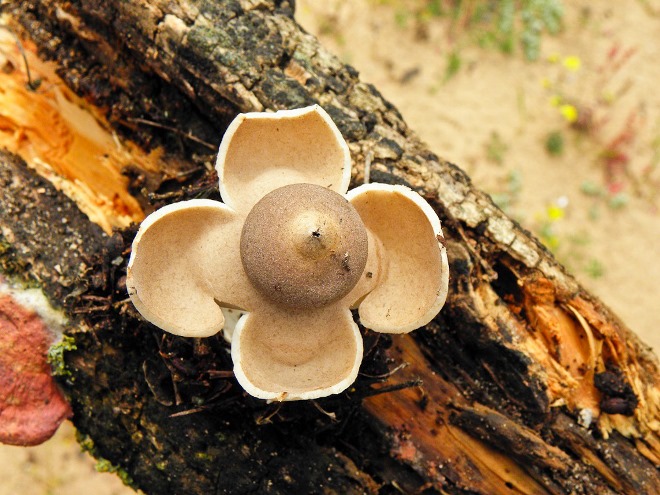
in nature, there are several varieties of geastrum, which are divided into conditionally edible and inedible
Similar species
Small starfish belongs to the inedible similar species. It grows in areas dominated by limestone. The speaking name indicates the small size of the cap during the period of underground development.
However, the shell of the fruiting body is divided into 10-12 parts. The four-bladed starlet has only 4 of them.
In addition, in this species, the upper surface of the endoperidium is smooth, and the vaulted specimens on the skin have microscopic fibers that resemble eyelashes.
A description of the starfish called striped says that this mushroom is small in size and light in color in the early stages of development. Its fruiting body resembles a bulb.
This species grows in soils with a high alkali content. For normal development, this starfish requires a lot of moisture, so you can find it in wetlands. The pulp can be eaten by pre-fried or boiled. Some mushroom pickers claim that when cooked, this mushroom tastes like champignons.
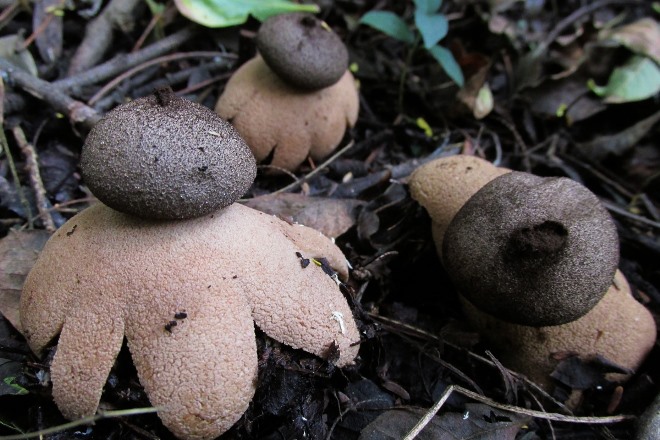
black-headed starfish belongs to the inedible species of geastrum
In warm forests, where mainly deciduous trees grow, in city parks and squares, you can find black-headed starfish. The dark color of the fruiting body, framed by a brown shell, is more reminiscent of a flower rather than a star, as in other similar species. The mushroom is inedible.
Mushroom application
The benefits of earthen stars are closely related to their use. They do not have any toxic substances, they are similar to raincoats. They are rarely used for food: they do not have a pronounced taste or smell. Previously, such mushrooms are not boiled.
In folk medicine, the star and its controversy are more popular. They found practical applications:
- the body of a young starfish, cut into plates, replaces the plaster and dressings, because it successfully stops the blood and is able to help the speedy regeneration of the wound;
- a powder is made from mature spores, it is also added to medicinal tinctures;
- geastrum, or starfish, are rich in chemical components, therefore extracts from them are used as antiseptics and antineoplastic agents.
Rare earthen star mushroom
An earthen star mushroom in the forest near Ogre.
Mushrooms Earth Star - The most beautiful and rare mushrooms. Veselki.
The use of the vaulted starlet.
Vaulted stars are rarely used as useful mushrooms, since they are few in number. In folk medicine, these mushrooms are used as a hemostatic agent. Also, vaulted starfish have a strong antiseptic effect.
The structure of the vaulted stars includes a number of substances useful for the body. Mature spore powder is used to prepare medicinal tinctures and powders. To stop the blood, the starfish is cut into strips and applied to the wound, like a plaster.
Places of growth of vaulted starfish.
This type of starfish grows in the Russian temperate zone. In North America and Europe, this species is widespread, but everywhere it is rare. These mushrooms are most commonly found in Mexico and the southwestern United States. The vaulted starfish is listed in the UK Red Data Book, where it has been assigned the status of a vulnerable species.
Well-drained soils are the favorite habitats of vaulted starfish. You can find them in deciduous forests. These mushrooms bear fruit in small groups forming "witch circles". These mushrooms are harvested from early to late autumn.

Evaluation of the edibility of the vaulted starfish.
These mushrooms are suitable for food only at a young age, when the shape of the fruit bodies is similar to a ball.But young specimens are quite difficult to find, since during this period they are almost completely underground. Vaulted stars can be eaten fried, stewed and boiled.
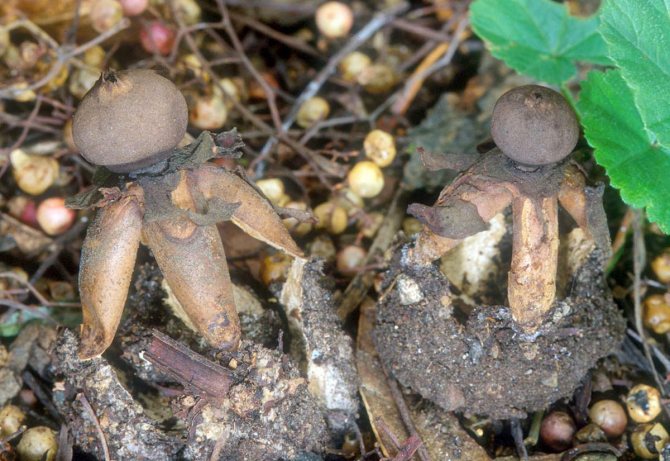
Related species.
The small starfish is an inedible relative of the vaulted starfish. The development of the fruiting body takes place underground. At first, it has a spherical shape, and later opens into 6-12 rays and takes the form of a star. The color of the rays is gray-beige. The pulp is white at first, and brown in adulthood. Small stars grow on calcareous soils. They can be found in clearings and forest edges, as well as in the steppes.
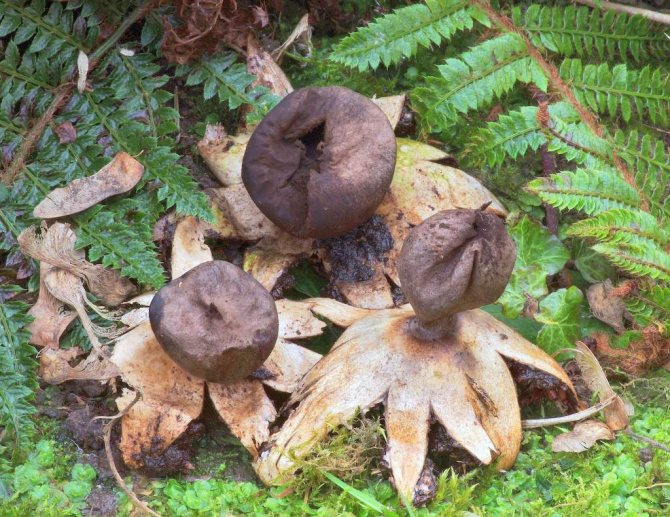
The striped starfish is also inedible. At an early age, the mushroom is underground, at this time it has the shape of a bulb. As the fungus grows, its outer shell breaks into blades with sharp ends. The blades are creamy. A spore ball is located in the center of the blades. At the top of the ball there is a stomata, from which ripe spores are ejected. It is a saprotroph mushroom and can be found in desert soil or decaying woody remains.

